Hewlett-Packard: A Critical Analysis of Organizational Behaviour
VerifiedAdded on 2024/06/11
|20
|5777
|364
AI Summary
This assignment delves into the intricate relationship between organizational culture, power, politics, and motivation within Hewlett-Packard (HP). It critically analyzes how these factors influence individual and team behavior, impacting performance, job satisfaction, and innovation. The assignment explores the effectiveness of Maslow's Hierarchy of Needs, Herzberg's Two-Factor Theory, and Vroom's Expectancy Theory in motivating employees and achieving organizational goals. It also examines the application of behavioral motivational theories, concepts, and models to influence behavior, drawing on practical examples from various organizations. Finally, the assignment critically evaluates the link between culture, politics, power, and motivation in driving team and organizational success, providing justified recommendations for HP to foster a positive and productive work environment.
Contribute Materials
Your contribution can guide someone’s learning journey. Share your
documents today.
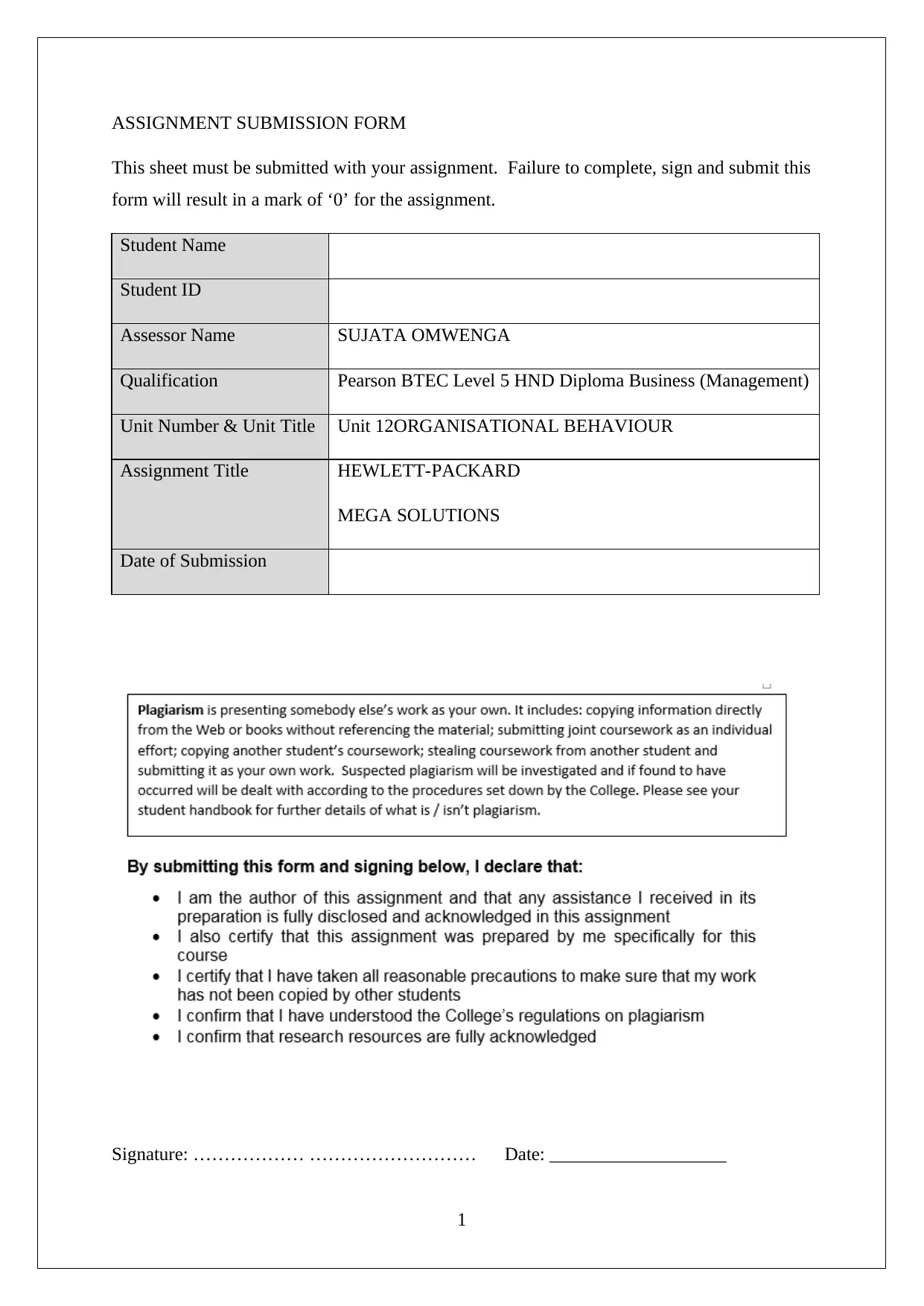
ASSIGNMENT SUBMISSION FORM
This sheet must be submitted with your assignment. Failure to complete, sign and submit this
form will result in a mark of ‘0’ for the assignment.
Student Name
Student ID
Assessor Name SUJATA OMWENGA
Qualification Pearson BTEC Level 5 HND Diploma Business (Management)
Unit Number & Unit Title Unit 12ORGANISATIONAL BEHAVIOUR
Assignment Title HEWLETT-PACKARD
MEGA SOLUTIONS
Date of Submission
Signature: ……………… ……………………… Date: ___________________
1
This sheet must be submitted with your assignment. Failure to complete, sign and submit this
form will result in a mark of ‘0’ for the assignment.
Student Name
Student ID
Assessor Name SUJATA OMWENGA
Qualification Pearson BTEC Level 5 HND Diploma Business (Management)
Unit Number & Unit Title Unit 12ORGANISATIONAL BEHAVIOUR
Assignment Title HEWLETT-PACKARD
MEGA SOLUTIONS
Date of Submission
Signature: ……………… ……………………… Date: ___________________
1
Secure Best Marks with AI Grader
Need help grading? Try our AI Grader for instant feedback on your assignments.
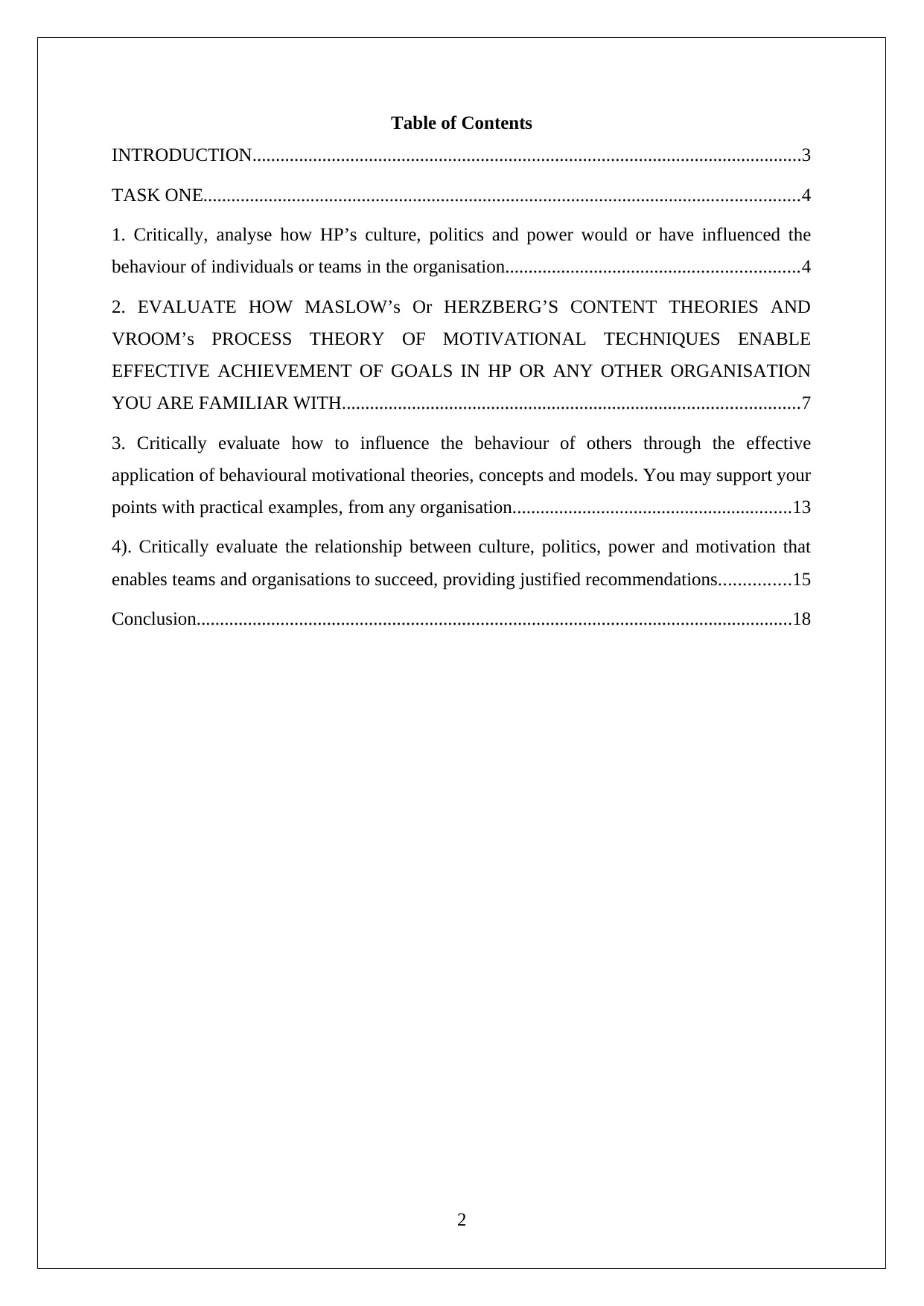
Table of Contents
INTRODUCTION......................................................................................................................3
TASK ONE................................................................................................................................4
1. Critically, analyse how HP’s culture, politics and power would or have influenced the
behaviour of individuals or teams in the organisation...............................................................4
2. EVALUATE HOW MASLOW’s Or HERZBERG’S CONTENT THEORIES AND
VROOM’s PROCESS THEORY OF MOTIVATIONAL TECHNIQUES ENABLE
EFFECTIVE ACHIEVEMENT OF GOALS IN HP OR ANY OTHER ORGANISATION
YOU ARE FAMILIAR WITH..................................................................................................7
3. Critically evaluate how to influence the behaviour of others through the effective
application of behavioural motivational theories, concepts and models. You may support your
points with practical examples, from any organisation............................................................13
4). Critically evaluate the relationship between culture, politics, power and motivation that
enables teams and organisations to succeed, providing justified recommendations...............15
Conclusion................................................................................................................................18
2
INTRODUCTION......................................................................................................................3
TASK ONE................................................................................................................................4
1. Critically, analyse how HP’s culture, politics and power would or have influenced the
behaviour of individuals or teams in the organisation...............................................................4
2. EVALUATE HOW MASLOW’s Or HERZBERG’S CONTENT THEORIES AND
VROOM’s PROCESS THEORY OF MOTIVATIONAL TECHNIQUES ENABLE
EFFECTIVE ACHIEVEMENT OF GOALS IN HP OR ANY OTHER ORGANISATION
YOU ARE FAMILIAR WITH..................................................................................................7
3. Critically evaluate how to influence the behaviour of others through the effective
application of behavioural motivational theories, concepts and models. You may support your
points with practical examples, from any organisation............................................................13
4). Critically evaluate the relationship between culture, politics, power and motivation that
enables teams and organisations to succeed, providing justified recommendations...............15
Conclusion................................................................................................................................18
2
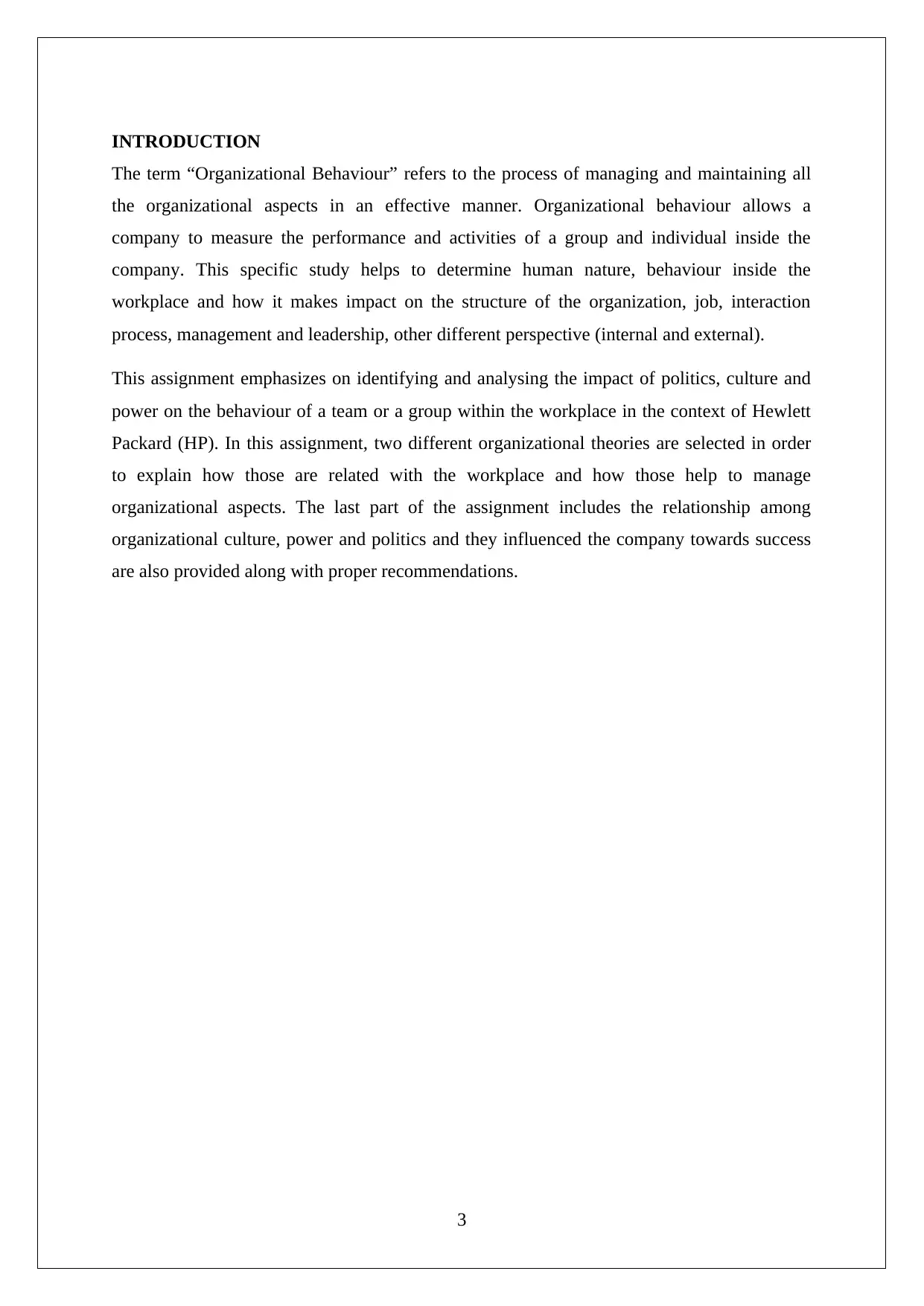
INTRODUCTION
The term “Organizational Behaviour” refers to the process of managing and maintaining all
the organizational aspects in an effective manner. Organizational behaviour allows a
company to measure the performance and activities of a group and individual inside the
company. This specific study helps to determine human nature, behaviour inside the
workplace and how it makes impact on the structure of the organization, job, interaction
process, management and leadership, other different perspective (internal and external).
This assignment emphasizes on identifying and analysing the impact of politics, culture and
power on the behaviour of a team or a group within the workplace in the context of Hewlett
Packard (HP). In this assignment, two different organizational theories are selected in order
to explain how those are related with the workplace and how those help to manage
organizational aspects. The last part of the assignment includes the relationship among
organizational culture, power and politics and they influenced the company towards success
are also provided along with proper recommendations.
3
The term “Organizational Behaviour” refers to the process of managing and maintaining all
the organizational aspects in an effective manner. Organizational behaviour allows a
company to measure the performance and activities of a group and individual inside the
company. This specific study helps to determine human nature, behaviour inside the
workplace and how it makes impact on the structure of the organization, job, interaction
process, management and leadership, other different perspective (internal and external).
This assignment emphasizes on identifying and analysing the impact of politics, culture and
power on the behaviour of a team or a group within the workplace in the context of Hewlett
Packard (HP). In this assignment, two different organizational theories are selected in order
to explain how those are related with the workplace and how those help to manage
organizational aspects. The last part of the assignment includes the relationship among
organizational culture, power and politics and they influenced the company towards success
are also provided along with proper recommendations.
3
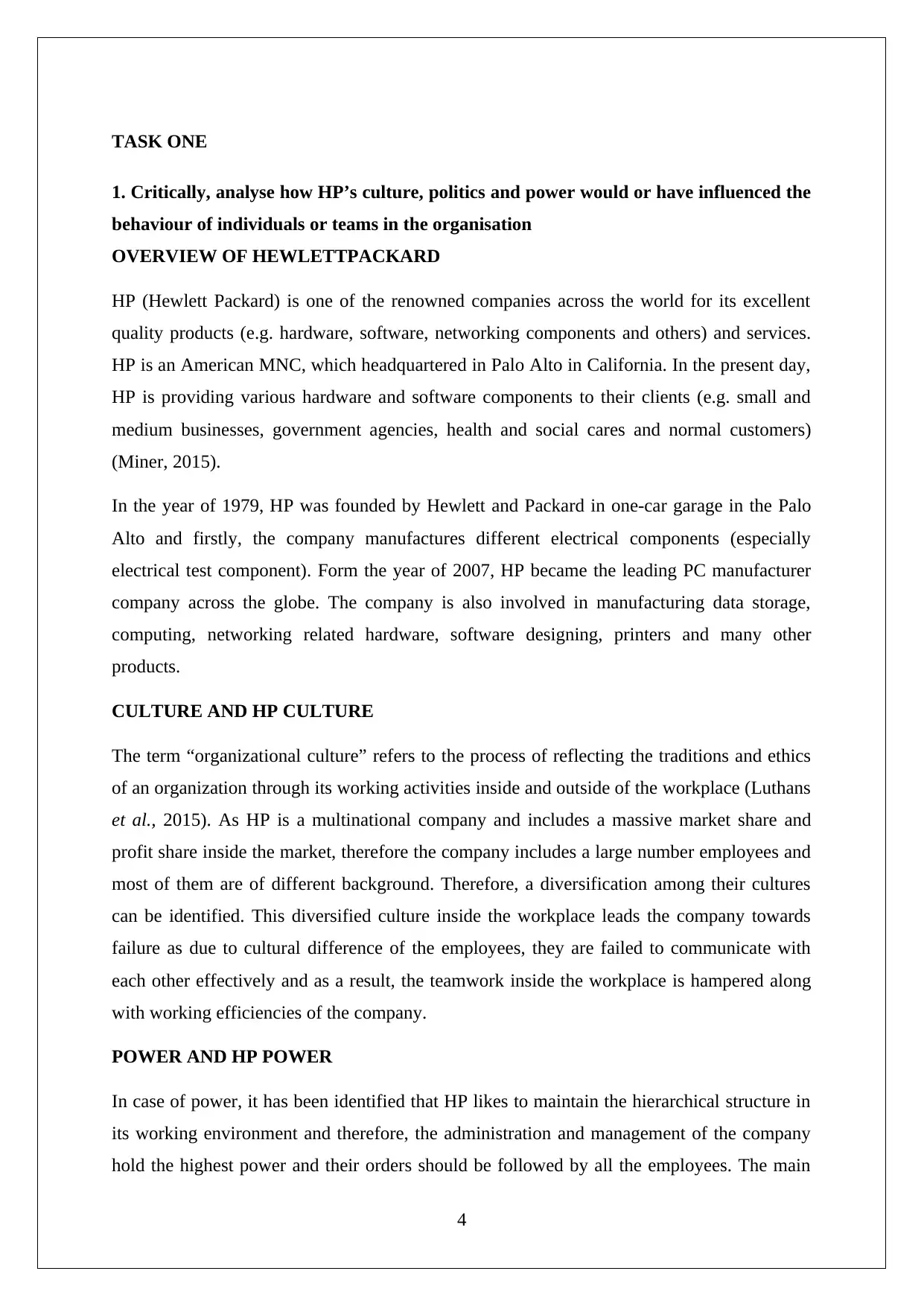
TASK ONE
1. Critically, analyse how HP’s culture, politics and power would or have influenced the
behaviour of individuals or teams in the organisation
OVERVIEW OF HEWLETTPACKARD
HP (Hewlett Packard) is one of the renowned companies across the world for its excellent
quality products (e.g. hardware, software, networking components and others) and services.
HP is an American MNC, which headquartered in Palo Alto in California. In the present day,
HP is providing various hardware and software components to their clients (e.g. small and
medium businesses, government agencies, health and social cares and normal customers)
(Miner, 2015).
In the year of 1979, HP was founded by Hewlett and Packard in one-car garage in the Palo
Alto and firstly, the company manufactures different electrical components (especially
electrical test component). Form the year of 2007, HP became the leading PC manufacturer
company across the globe. The company is also involved in manufacturing data storage,
computing, networking related hardware, software designing, printers and many other
products.
CULTURE AND HP CULTURE
The term “organizational culture” refers to the process of reflecting the traditions and ethics
of an organization through its working activities inside and outside of the workplace (Luthans
et al., 2015). As HP is a multinational company and includes a massive market share and
profit share inside the market, therefore the company includes a large number employees and
most of them are of different background. Therefore, a diversification among their cultures
can be identified. This diversified culture inside the workplace leads the company towards
failure as due to cultural difference of the employees, they are failed to communicate with
each other effectively and as a result, the teamwork inside the workplace is hampered along
with working efficiencies of the company.
POWER AND HP POWER
In case of power, it has been identified that HP likes to maintain the hierarchical structure in
its working environment and therefore, the administration and management of the company
hold the highest power and their orders should be followed by all the employees. The main
4
1. Critically, analyse how HP’s culture, politics and power would or have influenced the
behaviour of individuals or teams in the organisation
OVERVIEW OF HEWLETTPACKARD
HP (Hewlett Packard) is one of the renowned companies across the world for its excellent
quality products (e.g. hardware, software, networking components and others) and services.
HP is an American MNC, which headquartered in Palo Alto in California. In the present day,
HP is providing various hardware and software components to their clients (e.g. small and
medium businesses, government agencies, health and social cares and normal customers)
(Miner, 2015).
In the year of 1979, HP was founded by Hewlett and Packard in one-car garage in the Palo
Alto and firstly, the company manufactures different electrical components (especially
electrical test component). Form the year of 2007, HP became the leading PC manufacturer
company across the globe. The company is also involved in manufacturing data storage,
computing, networking related hardware, software designing, printers and many other
products.
CULTURE AND HP CULTURE
The term “organizational culture” refers to the process of reflecting the traditions and ethics
of an organization through its working activities inside and outside of the workplace (Luthans
et al., 2015). As HP is a multinational company and includes a massive market share and
profit share inside the market, therefore the company includes a large number employees and
most of them are of different background. Therefore, a diversification among their cultures
can be identified. This diversified culture inside the workplace leads the company towards
failure as due to cultural difference of the employees, they are failed to communicate with
each other effectively and as a result, the teamwork inside the workplace is hampered along
with working efficiencies of the company.
POWER AND HP POWER
In case of power, it has been identified that HP likes to maintain the hierarchical structure in
its working environment and therefore, the administration and management of the company
hold the highest power and their orders should be followed by all the employees. The main
4
Secure Best Marks with AI Grader
Need help grading? Try our AI Grader for instant feedback on your assignments.
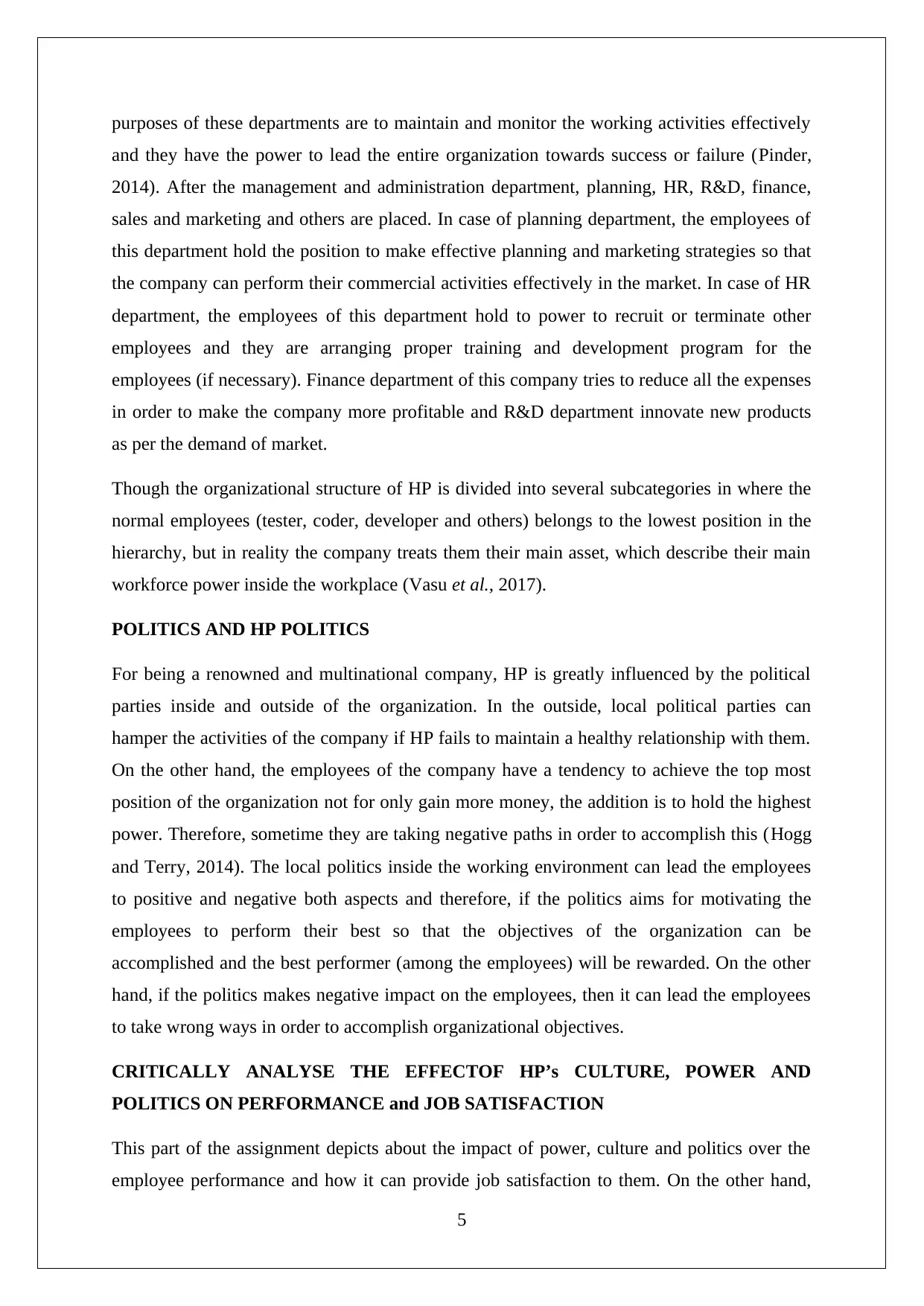
purposes of these departments are to maintain and monitor the working activities effectively
and they have the power to lead the entire organization towards success or failure (Pinder,
2014). After the management and administration department, planning, HR, R&D, finance,
sales and marketing and others are placed. In case of planning department, the employees of
this department hold the position to make effective planning and marketing strategies so that
the company can perform their commercial activities effectively in the market. In case of HR
department, the employees of this department hold to power to recruit or terminate other
employees and they are arranging proper training and development program for the
employees (if necessary). Finance department of this company tries to reduce all the expenses
in order to make the company more profitable and R&D department innovate new products
as per the demand of market.
Though the organizational structure of HP is divided into several subcategories in where the
normal employees (tester, coder, developer and others) belongs to the lowest position in the
hierarchy, but in reality the company treats them their main asset, which describe their main
workforce power inside the workplace (Vasu et al., 2017).
POLITICS AND HP POLITICS
For being a renowned and multinational company, HP is greatly influenced by the political
parties inside and outside of the organization. In the outside, local political parties can
hamper the activities of the company if HP fails to maintain a healthy relationship with them.
On the other hand, the employees of the company have a tendency to achieve the top most
position of the organization not for only gain more money, the addition is to hold the highest
power. Therefore, sometime they are taking negative paths in order to accomplish this (Hogg
and Terry, 2014). The local politics inside the working environment can lead the employees
to positive and negative both aspects and therefore, if the politics aims for motivating the
employees to perform their best so that the objectives of the organization can be
accomplished and the best performer (among the employees) will be rewarded. On the other
hand, if the politics makes negative impact on the employees, then it can lead the employees
to take wrong ways in order to accomplish organizational objectives.
CRITICALLY ANALYSE THE EFFECTOF HP’s CULTURE, POWER AND
POLITICS ON PERFORMANCE and JOB SATISFACTION
This part of the assignment depicts about the impact of power, culture and politics over the
employee performance and how it can provide job satisfaction to them. On the other hand,
5
and they have the power to lead the entire organization towards success or failure (Pinder,
2014). After the management and administration department, planning, HR, R&D, finance,
sales and marketing and others are placed. In case of planning department, the employees of
this department hold the position to make effective planning and marketing strategies so that
the company can perform their commercial activities effectively in the market. In case of HR
department, the employees of this department hold to power to recruit or terminate other
employees and they are arranging proper training and development program for the
employees (if necessary). Finance department of this company tries to reduce all the expenses
in order to make the company more profitable and R&D department innovate new products
as per the demand of market.
Though the organizational structure of HP is divided into several subcategories in where the
normal employees (tester, coder, developer and others) belongs to the lowest position in the
hierarchy, but in reality the company treats them their main asset, which describe their main
workforce power inside the workplace (Vasu et al., 2017).
POLITICS AND HP POLITICS
For being a renowned and multinational company, HP is greatly influenced by the political
parties inside and outside of the organization. In the outside, local political parties can
hamper the activities of the company if HP fails to maintain a healthy relationship with them.
On the other hand, the employees of the company have a tendency to achieve the top most
position of the organization not for only gain more money, the addition is to hold the highest
power. Therefore, sometime they are taking negative paths in order to accomplish this (Hogg
and Terry, 2014). The local politics inside the working environment can lead the employees
to positive and negative both aspects and therefore, if the politics aims for motivating the
employees to perform their best so that the objectives of the organization can be
accomplished and the best performer (among the employees) will be rewarded. On the other
hand, if the politics makes negative impact on the employees, then it can lead the employees
to take wrong ways in order to accomplish organizational objectives.
CRITICALLY ANALYSE THE EFFECTOF HP’s CULTURE, POWER AND
POLITICS ON PERFORMANCE and JOB SATISFACTION
This part of the assignment depicts about the impact of power, culture and politics over the
employee performance and how it can provide job satisfaction to them. On the other hand,
5
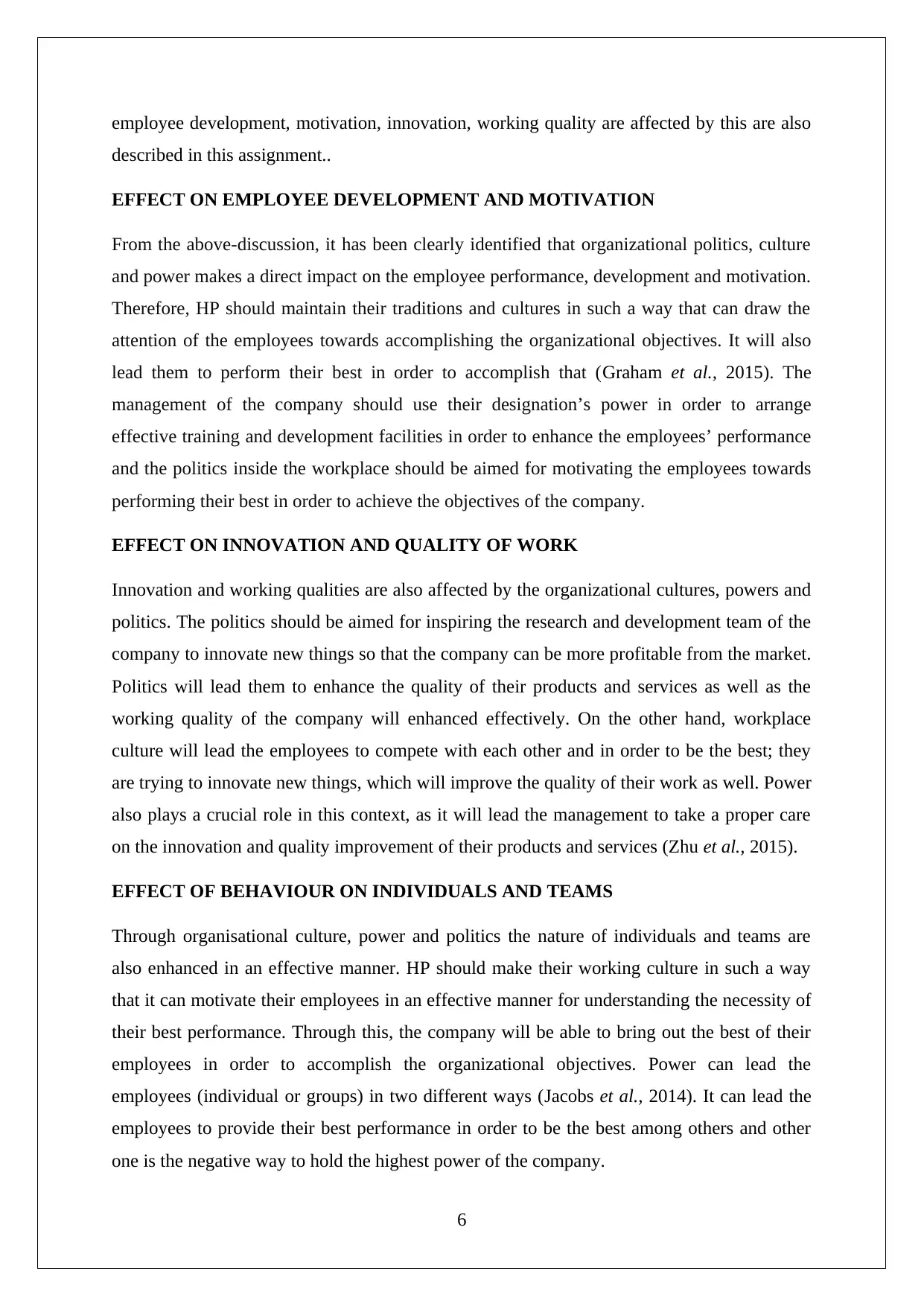
employee development, motivation, innovation, working quality are affected by this are also
described in this assignment..
EFFECT ON EMPLOYEE DEVELOPMENT AND MOTIVATION
From the above-discussion, it has been clearly identified that organizational politics, culture
and power makes a direct impact on the employee performance, development and motivation.
Therefore, HP should maintain their traditions and cultures in such a way that can draw the
attention of the employees towards accomplishing the organizational objectives. It will also
lead them to perform their best in order to accomplish that (Graham et al., 2015). The
management of the company should use their designation’s power in order to arrange
effective training and development facilities in order to enhance the employees’ performance
and the politics inside the workplace should be aimed for motivating the employees towards
performing their best in order to achieve the objectives of the company.
EFFECT ON INNOVATION AND QUALITY OF WORK
Innovation and working qualities are also affected by the organizational cultures, powers and
politics. The politics should be aimed for inspiring the research and development team of the
company to innovate new things so that the company can be more profitable from the market.
Politics will lead them to enhance the quality of their products and services as well as the
working quality of the company will enhanced effectively. On the other hand, workplace
culture will lead the employees to compete with each other and in order to be the best; they
are trying to innovate new things, which will improve the quality of their work as well. Power
also plays a crucial role in this context, as it will lead the management to take a proper care
on the innovation and quality improvement of their products and services (Zhu et al., 2015).
EFFECT OF BEHAVIOUR ON INDIVIDUALS AND TEAMS
Through organisational culture, power and politics the nature of individuals and teams are
also enhanced in an effective manner. HP should make their working culture in such a way
that it can motivate their employees in an effective manner for understanding the necessity of
their best performance. Through this, the company will be able to bring out the best of their
employees in order to accomplish the organizational objectives. Power can lead the
employees (individual or groups) in two different ways (Jacobs et al., 2014). It can lead the
employees to provide their best performance in order to be the best among others and other
one is the negative way to hold the highest power of the company.
6
described in this assignment..
EFFECT ON EMPLOYEE DEVELOPMENT AND MOTIVATION
From the above-discussion, it has been clearly identified that organizational politics, culture
and power makes a direct impact on the employee performance, development and motivation.
Therefore, HP should maintain their traditions and cultures in such a way that can draw the
attention of the employees towards accomplishing the organizational objectives. It will also
lead them to perform their best in order to accomplish that (Graham et al., 2015). The
management of the company should use their designation’s power in order to arrange
effective training and development facilities in order to enhance the employees’ performance
and the politics inside the workplace should be aimed for motivating the employees towards
performing their best in order to achieve the objectives of the company.
EFFECT ON INNOVATION AND QUALITY OF WORK
Innovation and working qualities are also affected by the organizational cultures, powers and
politics. The politics should be aimed for inspiring the research and development team of the
company to innovate new things so that the company can be more profitable from the market.
Politics will lead them to enhance the quality of their products and services as well as the
working quality of the company will enhanced effectively. On the other hand, workplace
culture will lead the employees to compete with each other and in order to be the best; they
are trying to innovate new things, which will improve the quality of their work as well. Power
also plays a crucial role in this context, as it will lead the management to take a proper care
on the innovation and quality improvement of their products and services (Zhu et al., 2015).
EFFECT OF BEHAVIOUR ON INDIVIDUALS AND TEAMS
Through organisational culture, power and politics the nature of individuals and teams are
also enhanced in an effective manner. HP should make their working culture in such a way
that it can motivate their employees in an effective manner for understanding the necessity of
their best performance. Through this, the company will be able to bring out the best of their
employees in order to accomplish the organizational objectives. Power can lead the
employees (individual or groups) in two different ways (Jacobs et al., 2014). It can lead the
employees to provide their best performance in order to be the best among others and other
one is the negative way to hold the highest power of the company.
6

2. EVALUATE HOW MASLOW’s Or HERZBERG’S CONTENT THEORIES AND
VROOM’s PROCESS THEORY OF MOTIVATIONAL TECHNIQUES ENABLE
EFFECTIVE ACHIEVEMENT OF GOALS IN HP OR ANY OTHER
ORGANISATION YOU ARE FAMILIAR WITH.
EXPLAIN HIERARCHY OF NEEDS THEORY
Maslow’s motivational theory is one of the most effective thesis, which are invented by the
researcher in the mid-century and according to this theory, every basic needs of the human
being are highlighted and fulfilled. In case of basic needs of the human-being, food, cloth and
home are taken into consideration. In case of Maslow’s need theory self-actualization, esteem
needs, belongingness and love needs, safety needs and psychological and biological needs are
the crucial factors, which implies all the demands of human beings and those can be
described as follows-
Figure 1: Maslow’s hierarchical need theory
(Source: Ashkanasy et al., 2014)
Psychological and biological needs: Needs refer to the basic three needs of human beings,
which they required for survive in the world (e.g. food, cloth and home). Therefore, human
can do anything or can go any further extensions in order to achieve these three. In case HP,
these factors play a crucial role as every employee of HP is working for the company to earn
money, which are required to survive in the present world.
7
VROOM’s PROCESS THEORY OF MOTIVATIONAL TECHNIQUES ENABLE
EFFECTIVE ACHIEVEMENT OF GOALS IN HP OR ANY OTHER
ORGANISATION YOU ARE FAMILIAR WITH.
EXPLAIN HIERARCHY OF NEEDS THEORY
Maslow’s motivational theory is one of the most effective thesis, which are invented by the
researcher in the mid-century and according to this theory, every basic needs of the human
being are highlighted and fulfilled. In case of basic needs of the human-being, food, cloth and
home are taken into consideration. In case of Maslow’s need theory self-actualization, esteem
needs, belongingness and love needs, safety needs and psychological and biological needs are
the crucial factors, which implies all the demands of human beings and those can be
described as follows-
Figure 1: Maslow’s hierarchical need theory
(Source: Ashkanasy et al., 2014)
Psychological and biological needs: Needs refer to the basic three needs of human beings,
which they required for survive in the world (e.g. food, cloth and home). Therefore, human
can do anything or can go any further extensions in order to achieve these three. In case HP,
these factors play a crucial role as every employee of HP is working for the company to earn
money, which are required to survive in the present world.
7
Paraphrase This Document
Need a fresh take? Get an instant paraphrase of this document with our AI Paraphraser
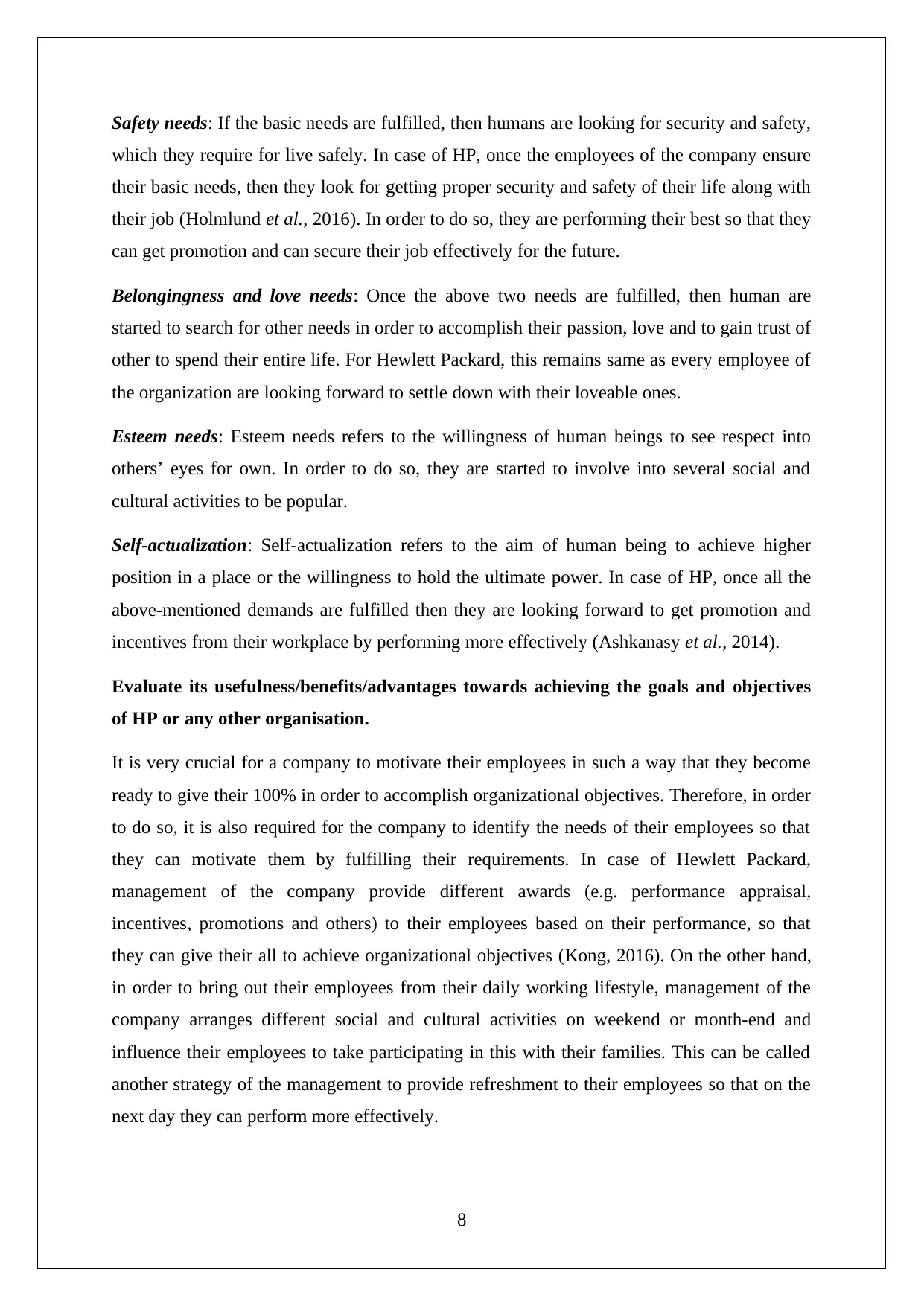
Safety needs: If the basic needs are fulfilled, then humans are looking for security and safety,
which they require for live safely. In case of HP, once the employees of the company ensure
their basic needs, then they look for getting proper security and safety of their life along with
their job (Holmlund et al., 2016). In order to do so, they are performing their best so that they
can get promotion and can secure their job effectively for the future.
Belongingness and love needs: Once the above two needs are fulfilled, then human are
started to search for other needs in order to accomplish their passion, love and to gain trust of
other to spend their entire life. For Hewlett Packard, this remains same as every employee of
the organization are looking forward to settle down with their loveable ones.
Esteem needs: Esteem needs refers to the willingness of human beings to see respect into
others’ eyes for own. In order to do so, they are started to involve into several social and
cultural activities to be popular.
Self-actualization: Self-actualization refers to the aim of human being to achieve higher
position in a place or the willingness to hold the ultimate power. In case of HP, once all the
above-mentioned demands are fulfilled then they are looking forward to get promotion and
incentives from their workplace by performing more effectively (Ashkanasy et al., 2014).
Evaluate its usefulness/benefits/advantages towards achieving the goals and objectives
of HP or any other organisation.
It is very crucial for a company to motivate their employees in such a way that they become
ready to give their 100% in order to accomplish organizational objectives. Therefore, in order
to do so, it is also required for the company to identify the needs of their employees so that
they can motivate them by fulfilling their requirements. In case of Hewlett Packard,
management of the company provide different awards (e.g. performance appraisal,
incentives, promotions and others) to their employees based on their performance, so that
they can give their all to achieve organizational objectives (Kong, 2016). On the other hand,
in order to bring out their employees from their daily working lifestyle, management of the
company arranges different social and cultural activities on weekend or month-end and
influence their employees to take participating in this with their families. This can be called
another strategy of the management to provide refreshment to their employees so that on the
next day they can perform more effectively.
8
which they require for live safely. In case of HP, once the employees of the company ensure
their basic needs, then they look for getting proper security and safety of their life along with
their job (Holmlund et al., 2016). In order to do so, they are performing their best so that they
can get promotion and can secure their job effectively for the future.
Belongingness and love needs: Once the above two needs are fulfilled, then human are
started to search for other needs in order to accomplish their passion, love and to gain trust of
other to spend their entire life. For Hewlett Packard, this remains same as every employee of
the organization are looking forward to settle down with their loveable ones.
Esteem needs: Esteem needs refers to the willingness of human beings to see respect into
others’ eyes for own. In order to do so, they are started to involve into several social and
cultural activities to be popular.
Self-actualization: Self-actualization refers to the aim of human being to achieve higher
position in a place or the willingness to hold the ultimate power. In case of HP, once all the
above-mentioned demands are fulfilled then they are looking forward to get promotion and
incentives from their workplace by performing more effectively (Ashkanasy et al., 2014).
Evaluate its usefulness/benefits/advantages towards achieving the goals and objectives
of HP or any other organisation.
It is very crucial for a company to motivate their employees in such a way that they become
ready to give their 100% in order to accomplish organizational objectives. Therefore, in order
to do so, it is also required for the company to identify the needs of their employees so that
they can motivate them by fulfilling their requirements. In case of Hewlett Packard,
management of the company provide different awards (e.g. performance appraisal,
incentives, promotions and others) to their employees based on their performance, so that
they can give their all to achieve organizational objectives (Kong, 2016). On the other hand,
in order to bring out their employees from their daily working lifestyle, management of the
company arranges different social and cultural activities on weekend or month-end and
influence their employees to take participating in this with their families. This can be called
another strategy of the management to provide refreshment to their employees so that on the
next day they can perform more effectively.
8
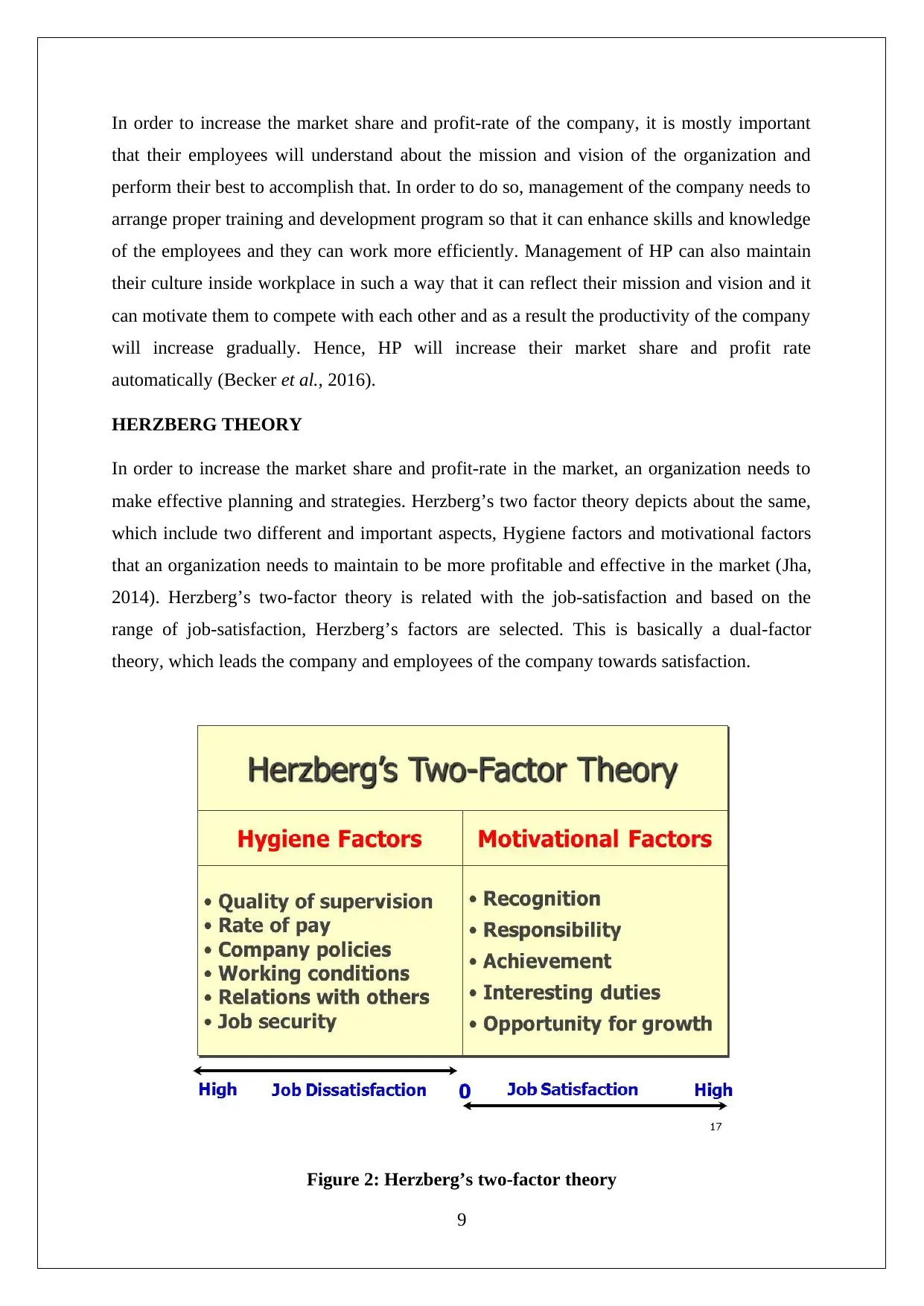
In order to increase the market share and profit-rate of the company, it is mostly important
that their employees will understand about the mission and vision of the organization and
perform their best to accomplish that. In order to do so, management of the company needs to
arrange proper training and development program so that it can enhance skills and knowledge
of the employees and they can work more efficiently. Management of HP can also maintain
their culture inside workplace in such a way that it can reflect their mission and vision and it
can motivate them to compete with each other and as a result the productivity of the company
will increase gradually. Hence, HP will increase their market share and profit rate
automatically (Becker et al., 2016).
HERZBERG THEORY
In order to increase the market share and profit-rate in the market, an organization needs to
make effective planning and strategies. Herzberg’s two factor theory depicts about the same,
which include two different and important aspects, Hygiene factors and motivational factors
that an organization needs to maintain to be more profitable and effective in the market (Jha,
2014). Herzberg’s two-factor theory is related with the job-satisfaction and based on the
range of job-satisfaction, Herzberg’s factors are selected. This is basically a dual-factor
theory, which leads the company and employees of the company towards satisfaction.
Figure 2: Herzberg’s two-factor theory
9
that their employees will understand about the mission and vision of the organization and
perform their best to accomplish that. In order to do so, management of the company needs to
arrange proper training and development program so that it can enhance skills and knowledge
of the employees and they can work more efficiently. Management of HP can also maintain
their culture inside workplace in such a way that it can reflect their mission and vision and it
can motivate them to compete with each other and as a result the productivity of the company
will increase gradually. Hence, HP will increase their market share and profit rate
automatically (Becker et al., 2016).
HERZBERG THEORY
In order to increase the market share and profit-rate in the market, an organization needs to
make effective planning and strategies. Herzberg’s two factor theory depicts about the same,
which include two different and important aspects, Hygiene factors and motivational factors
that an organization needs to maintain to be more profitable and effective in the market (Jha,
2014). Herzberg’s two-factor theory is related with the job-satisfaction and based on the
range of job-satisfaction, Herzberg’s factors are selected. This is basically a dual-factor
theory, which leads the company and employees of the company towards satisfaction.
Figure 2: Herzberg’s two-factor theory
9
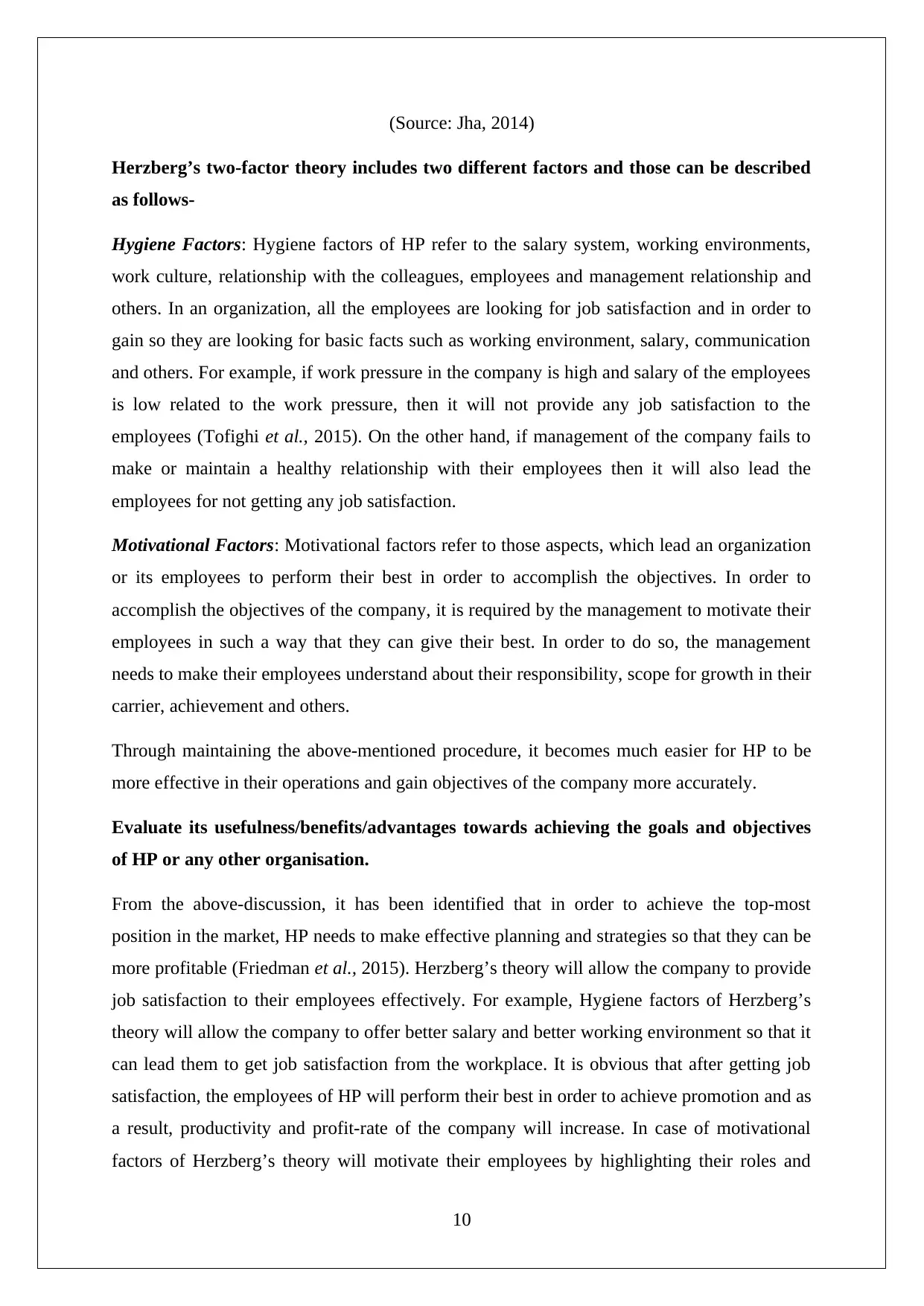
(Source: Jha, 2014)
Herzberg’s two-factor theory includes two different factors and those can be described
as follows-
Hygiene Factors: Hygiene factors of HP refer to the salary system, working environments,
work culture, relationship with the colleagues, employees and management relationship and
others. In an organization, all the employees are looking for job satisfaction and in order to
gain so they are looking for basic facts such as working environment, salary, communication
and others. For example, if work pressure in the company is high and salary of the employees
is low related to the work pressure, then it will not provide any job satisfaction to the
employees (Tofighi et al., 2015). On the other hand, if management of the company fails to
make or maintain a healthy relationship with their employees then it will also lead the
employees for not getting any job satisfaction.
Motivational Factors: Motivational factors refer to those aspects, which lead an organization
or its employees to perform their best in order to accomplish the objectives. In order to
accomplish the objectives of the company, it is required by the management to motivate their
employees in such a way that they can give their best. In order to do so, the management
needs to make their employees understand about their responsibility, scope for growth in their
carrier, achievement and others.
Through maintaining the above-mentioned procedure, it becomes much easier for HP to be
more effective in their operations and gain objectives of the company more accurately.
Evaluate its usefulness/benefits/advantages towards achieving the goals and objectives
of HP or any other organisation.
From the above-discussion, it has been identified that in order to achieve the top-most
position in the market, HP needs to make effective planning and strategies so that they can be
more profitable (Friedman et al., 2015). Herzberg’s theory will allow the company to provide
job satisfaction to their employees effectively. For example, Hygiene factors of Herzberg’s
theory will allow the company to offer better salary and better working environment so that it
can lead them to get job satisfaction from the workplace. It is obvious that after getting job
satisfaction, the employees of HP will perform their best in order to achieve promotion and as
a result, productivity and profit-rate of the company will increase. In case of motivational
factors of Herzberg’s theory will motivate their employees by highlighting their roles and
10
Herzberg’s two-factor theory includes two different factors and those can be described
as follows-
Hygiene Factors: Hygiene factors of HP refer to the salary system, working environments,
work culture, relationship with the colleagues, employees and management relationship and
others. In an organization, all the employees are looking for job satisfaction and in order to
gain so they are looking for basic facts such as working environment, salary, communication
and others. For example, if work pressure in the company is high and salary of the employees
is low related to the work pressure, then it will not provide any job satisfaction to the
employees (Tofighi et al., 2015). On the other hand, if management of the company fails to
make or maintain a healthy relationship with their employees then it will also lead the
employees for not getting any job satisfaction.
Motivational Factors: Motivational factors refer to those aspects, which lead an organization
or its employees to perform their best in order to accomplish the objectives. In order to
accomplish the objectives of the company, it is required by the management to motivate their
employees in such a way that they can give their best. In order to do so, the management
needs to make their employees understand about their responsibility, scope for growth in their
carrier, achievement and others.
Through maintaining the above-mentioned procedure, it becomes much easier for HP to be
more effective in their operations and gain objectives of the company more accurately.
Evaluate its usefulness/benefits/advantages towards achieving the goals and objectives
of HP or any other organisation.
From the above-discussion, it has been identified that in order to achieve the top-most
position in the market, HP needs to make effective planning and strategies so that they can be
more profitable (Friedman et al., 2015). Herzberg’s theory will allow the company to provide
job satisfaction to their employees effectively. For example, Hygiene factors of Herzberg’s
theory will allow the company to offer better salary and better working environment so that it
can lead them to get job satisfaction from the workplace. It is obvious that after getting job
satisfaction, the employees of HP will perform their best in order to achieve promotion and as
a result, productivity and profit-rate of the company will increase. In case of motivational
factors of Herzberg’s theory will motivate their employees by highlighting their roles and
10
Secure Best Marks with AI Grader
Need help grading? Try our AI Grader for instant feedback on your assignments.
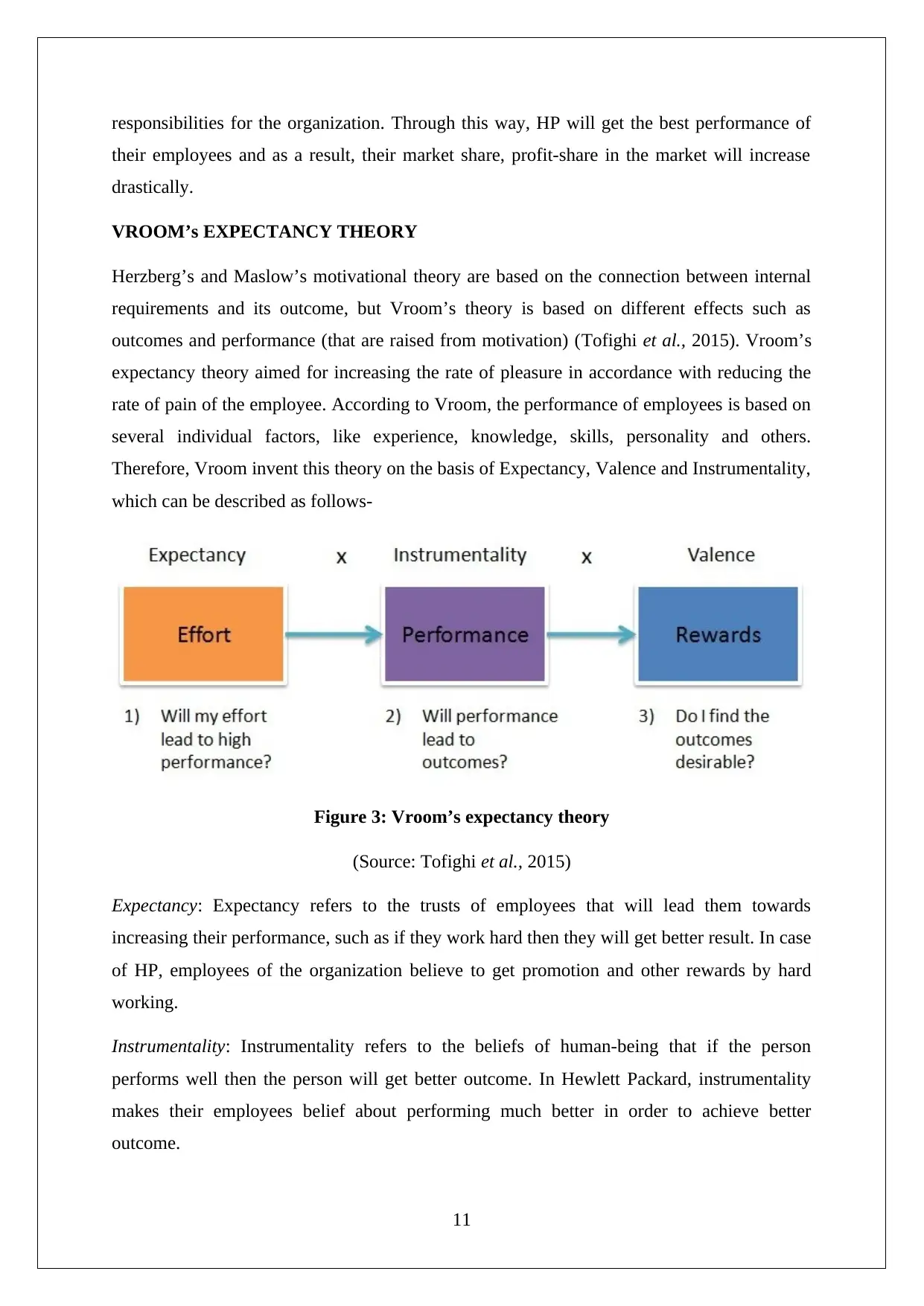
responsibilities for the organization. Through this way, HP will get the best performance of
their employees and as a result, their market share, profit-share in the market will increase
drastically.
VROOM’s EXPECTANCY THEORY
Herzberg’s and Maslow’s motivational theory are based on the connection between internal
requirements and its outcome, but Vroom’s theory is based on different effects such as
outcomes and performance (that are raised from motivation) (Tofighi et al., 2015). Vroom’s
expectancy theory aimed for increasing the rate of pleasure in accordance with reducing the
rate of pain of the employee. According to Vroom, the performance of employees is based on
several individual factors, like experience, knowledge, skills, personality and others.
Therefore, Vroom invent this theory on the basis of Expectancy, Valence and Instrumentality,
which can be described as follows-
Figure 3: Vroom’s expectancy theory
(Source: Tofighi et al., 2015)
Expectancy: Expectancy refers to the trusts of employees that will lead them towards
increasing their performance, such as if they work hard then they will get better result. In case
of HP, employees of the organization believe to get promotion and other rewards by hard
working.
Instrumentality: Instrumentality refers to the beliefs of human-being that if the person
performs well then the person will get better outcome. In Hewlett Packard, instrumentality
makes their employees belief about performing much better in order to achieve better
outcome.
11
their employees and as a result, their market share, profit-share in the market will increase
drastically.
VROOM’s EXPECTANCY THEORY
Herzberg’s and Maslow’s motivational theory are based on the connection between internal
requirements and its outcome, but Vroom’s theory is based on different effects such as
outcomes and performance (that are raised from motivation) (Tofighi et al., 2015). Vroom’s
expectancy theory aimed for increasing the rate of pleasure in accordance with reducing the
rate of pain of the employee. According to Vroom, the performance of employees is based on
several individual factors, like experience, knowledge, skills, personality and others.
Therefore, Vroom invent this theory on the basis of Expectancy, Valence and Instrumentality,
which can be described as follows-
Figure 3: Vroom’s expectancy theory
(Source: Tofighi et al., 2015)
Expectancy: Expectancy refers to the trusts of employees that will lead them towards
increasing their performance, such as if they work hard then they will get better result. In case
of HP, employees of the organization believe to get promotion and other rewards by hard
working.
Instrumentality: Instrumentality refers to the beliefs of human-being that if the person
performs well then the person will get better outcome. In Hewlett Packard, instrumentality
makes their employees belief about performing much better in order to achieve better
outcome.
11
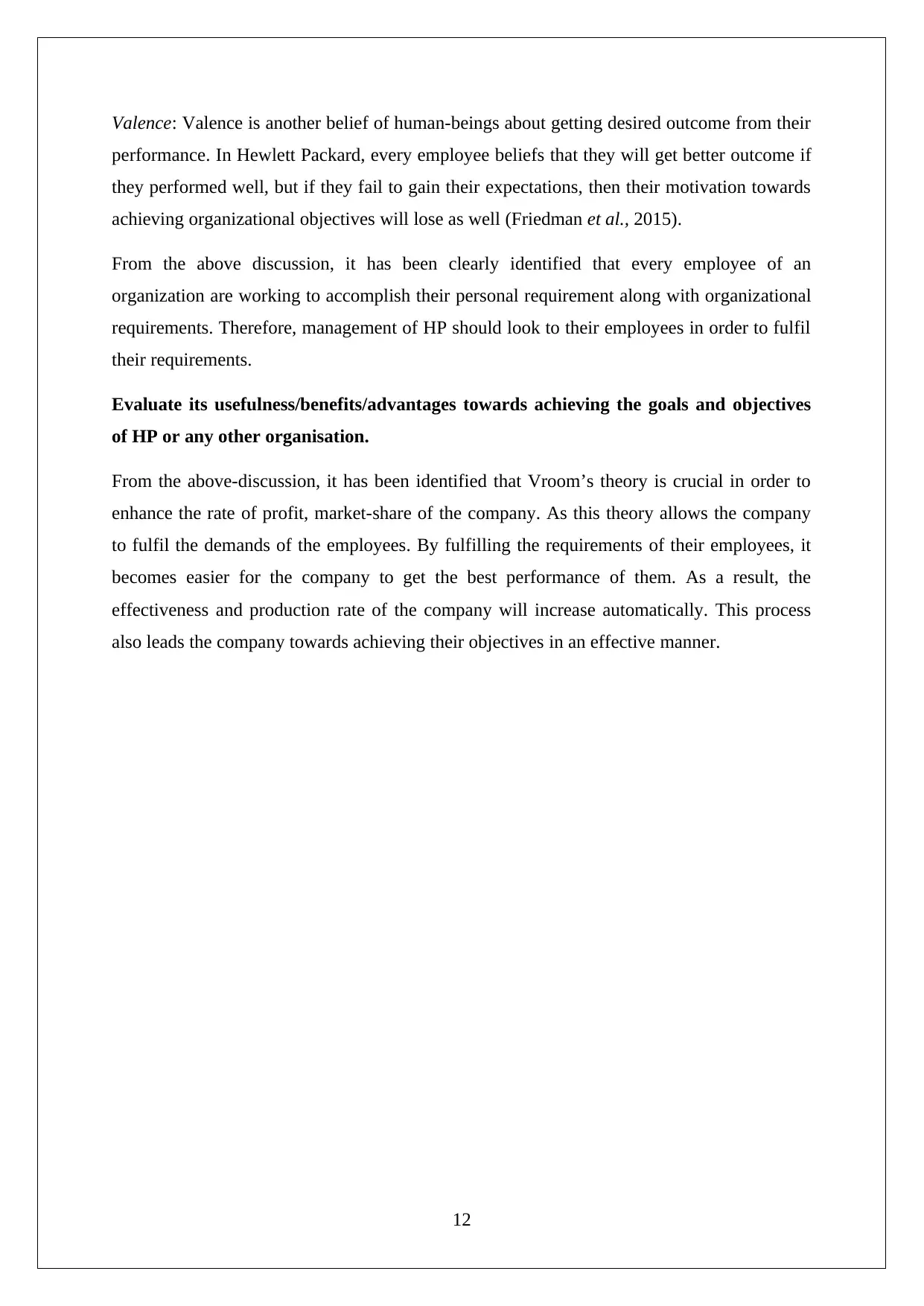
Valence: Valence is another belief of human-beings about getting desired outcome from their
performance. In Hewlett Packard, every employee beliefs that they will get better outcome if
they performed well, but if they fail to gain their expectations, then their motivation towards
achieving organizational objectives will lose as well (Friedman et al., 2015).
From the above discussion, it has been clearly identified that every employee of an
organization are working to accomplish their personal requirement along with organizational
requirements. Therefore, management of HP should look to their employees in order to fulfil
their requirements.
Evaluate its usefulness/benefits/advantages towards achieving the goals and objectives
of HP or any other organisation.
From the above-discussion, it has been identified that Vroom’s theory is crucial in order to
enhance the rate of profit, market-share of the company. As this theory allows the company
to fulfil the demands of the employees. By fulfilling the requirements of their employees, it
becomes easier for the company to get the best performance of them. As a result, the
effectiveness and production rate of the company will increase automatically. This process
also leads the company towards achieving their objectives in an effective manner.
12
performance. In Hewlett Packard, every employee beliefs that they will get better outcome if
they performed well, but if they fail to gain their expectations, then their motivation towards
achieving organizational objectives will lose as well (Friedman et al., 2015).
From the above discussion, it has been clearly identified that every employee of an
organization are working to accomplish their personal requirement along with organizational
requirements. Therefore, management of HP should look to their employees in order to fulfil
their requirements.
Evaluate its usefulness/benefits/advantages towards achieving the goals and objectives
of HP or any other organisation.
From the above-discussion, it has been identified that Vroom’s theory is crucial in order to
enhance the rate of profit, market-share of the company. As this theory allows the company
to fulfil the demands of the employees. By fulfilling the requirements of their employees, it
becomes easier for the company to get the best performance of them. As a result, the
effectiveness and production rate of the company will increase automatically. This process
also leads the company towards achieving their objectives in an effective manner.
12
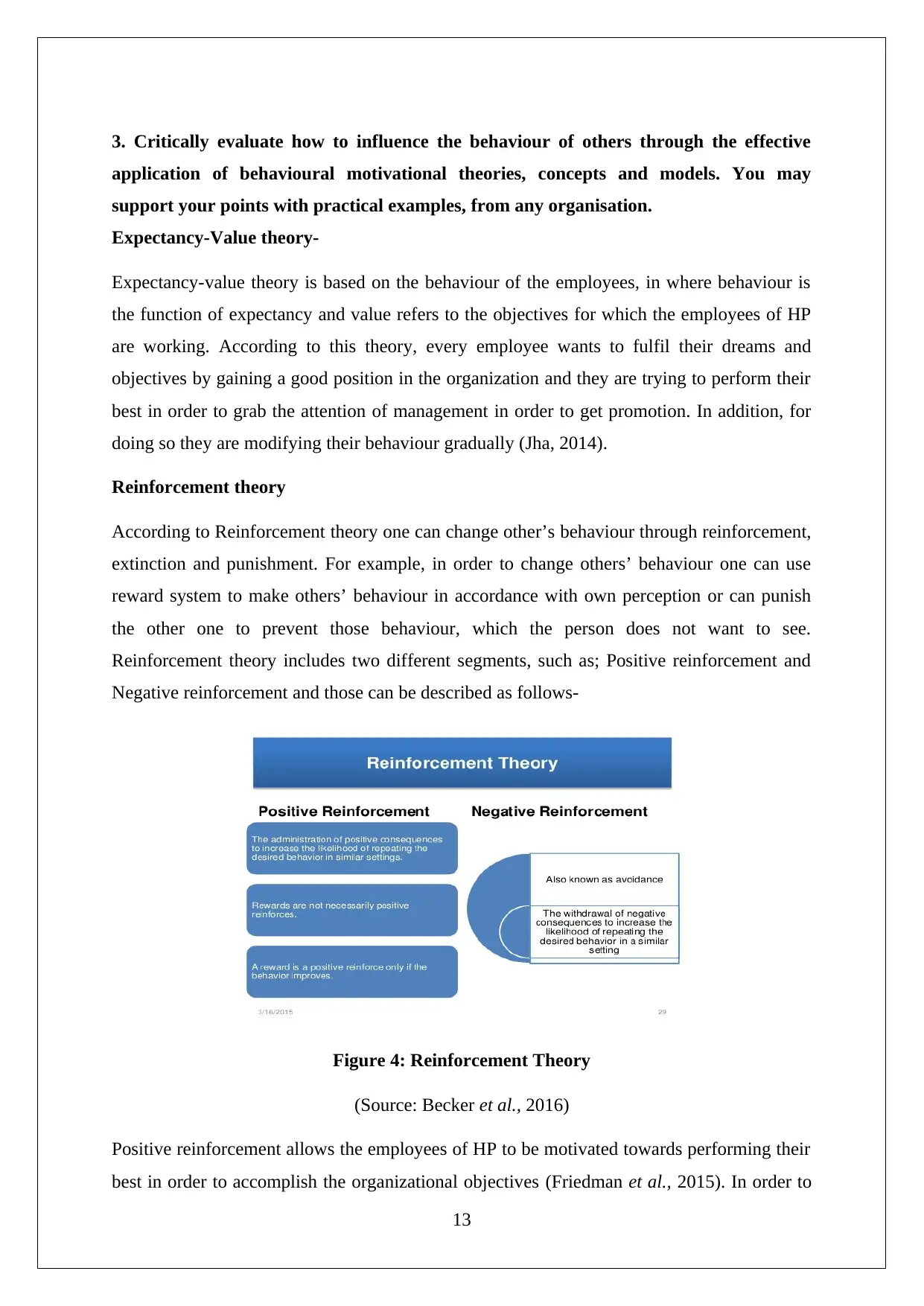
3. Critically evaluate how to influence the behaviour of others through the effective
application of behavioural motivational theories, concepts and models. You may
support your points with practical examples, from any organisation.
Expectancy-Value theory-
Expectancy-value theory is based on the behaviour of the employees, in where behaviour is
the function of expectancy and value refers to the objectives for which the employees of HP
are working. According to this theory, every employee wants to fulfil their dreams and
objectives by gaining a good position in the organization and they are trying to perform their
best in order to grab the attention of management in order to get promotion. In addition, for
doing so they are modifying their behaviour gradually (Jha, 2014).
Reinforcement theory
According to Reinforcement theory one can change other’s behaviour through reinforcement,
extinction and punishment. For example, in order to change others’ behaviour one can use
reward system to make others’ behaviour in accordance with own perception or can punish
the other one to prevent those behaviour, which the person does not want to see.
Reinforcement theory includes two different segments, such as; Positive reinforcement and
Negative reinforcement and those can be described as follows-
Figure 4: Reinforcement Theory
(Source: Becker et al., 2016)
Positive reinforcement allows the employees of HP to be motivated towards performing their
best in order to accomplish the organizational objectives (Friedman et al., 2015). In order to
13
application of behavioural motivational theories, concepts and models. You may
support your points with practical examples, from any organisation.
Expectancy-Value theory-
Expectancy-value theory is based on the behaviour of the employees, in where behaviour is
the function of expectancy and value refers to the objectives for which the employees of HP
are working. According to this theory, every employee wants to fulfil their dreams and
objectives by gaining a good position in the organization and they are trying to perform their
best in order to grab the attention of management in order to get promotion. In addition, for
doing so they are modifying their behaviour gradually (Jha, 2014).
Reinforcement theory
According to Reinforcement theory one can change other’s behaviour through reinforcement,
extinction and punishment. For example, in order to change others’ behaviour one can use
reward system to make others’ behaviour in accordance with own perception or can punish
the other one to prevent those behaviour, which the person does not want to see.
Reinforcement theory includes two different segments, such as; Positive reinforcement and
Negative reinforcement and those can be described as follows-
Figure 4: Reinforcement Theory
(Source: Becker et al., 2016)
Positive reinforcement allows the employees of HP to be motivated towards performing their
best in order to accomplish the organizational objectives (Friedman et al., 2015). In order to
13
Paraphrase This Document
Need a fresh take? Get an instant paraphrase of this document with our AI Paraphraser
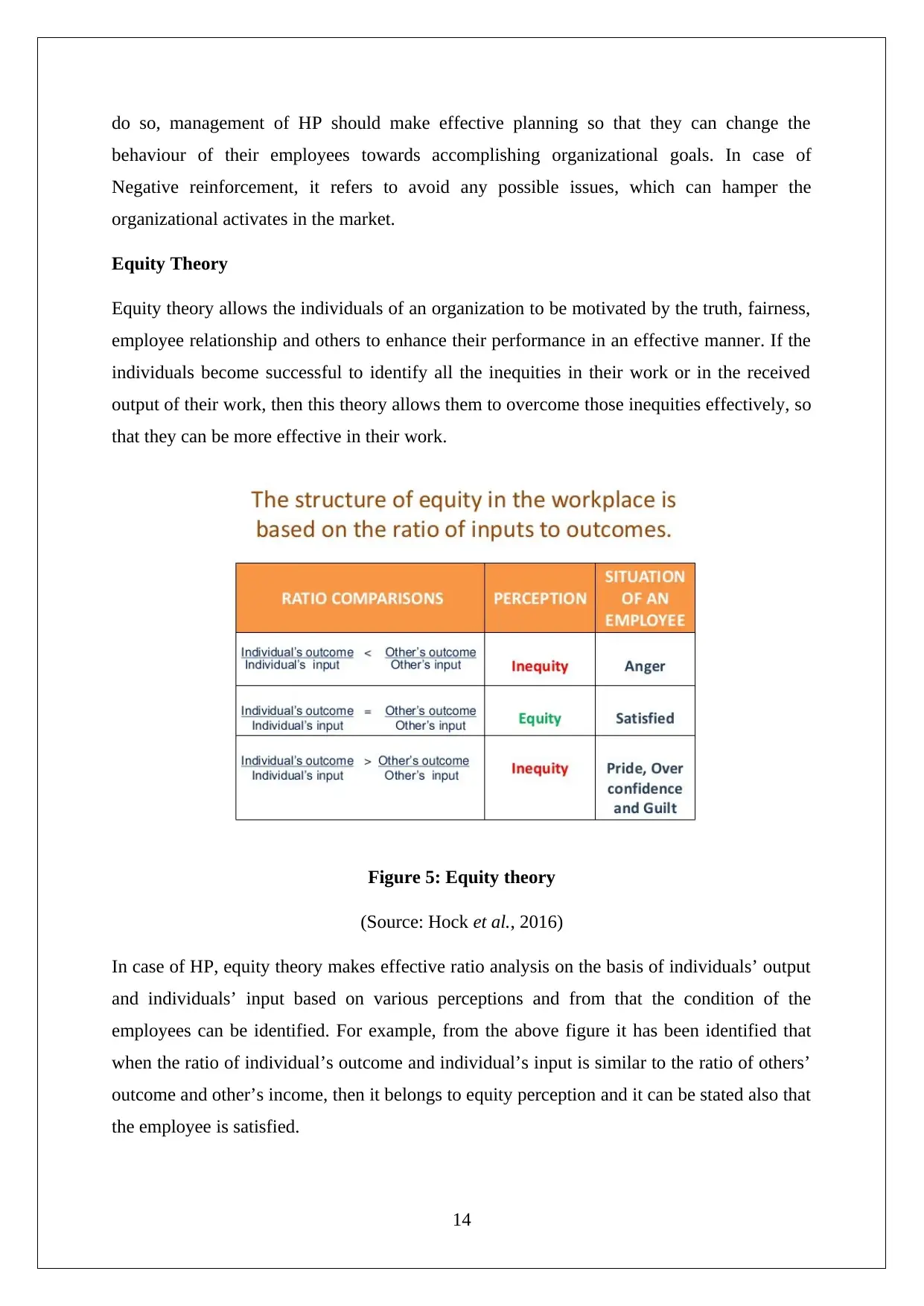
do so, management of HP should make effective planning so that they can change the
behaviour of their employees towards accomplishing organizational goals. In case of
Negative reinforcement, it refers to avoid any possible issues, which can hamper the
organizational activates in the market.
Equity Theory
Equity theory allows the individuals of an organization to be motivated by the truth, fairness,
employee relationship and others to enhance their performance in an effective manner. If the
individuals become successful to identify all the inequities in their work or in the received
output of their work, then this theory allows them to overcome those inequities effectively, so
that they can be more effective in their work.
Figure 5: Equity theory
(Source: Hock et al., 2016)
In case of HP, equity theory makes effective ratio analysis on the basis of individuals’ output
and individuals’ input based on various perceptions and from that the condition of the
employees can be identified. For example, from the above figure it has been identified that
when the ratio of individual’s outcome and individual’s input is similar to the ratio of others’
outcome and other’s income, then it belongs to equity perception and it can be stated also that
the employee is satisfied.
14
behaviour of their employees towards accomplishing organizational goals. In case of
Negative reinforcement, it refers to avoid any possible issues, which can hamper the
organizational activates in the market.
Equity Theory
Equity theory allows the individuals of an organization to be motivated by the truth, fairness,
employee relationship and others to enhance their performance in an effective manner. If the
individuals become successful to identify all the inequities in their work or in the received
output of their work, then this theory allows them to overcome those inequities effectively, so
that they can be more effective in their work.
Figure 5: Equity theory
(Source: Hock et al., 2016)
In case of HP, equity theory makes effective ratio analysis on the basis of individuals’ output
and individuals’ input based on various perceptions and from that the condition of the
employees can be identified. For example, from the above figure it has been identified that
when the ratio of individual’s outcome and individual’s input is similar to the ratio of others’
outcome and other’s income, then it belongs to equity perception and it can be stated also that
the employee is satisfied.
14
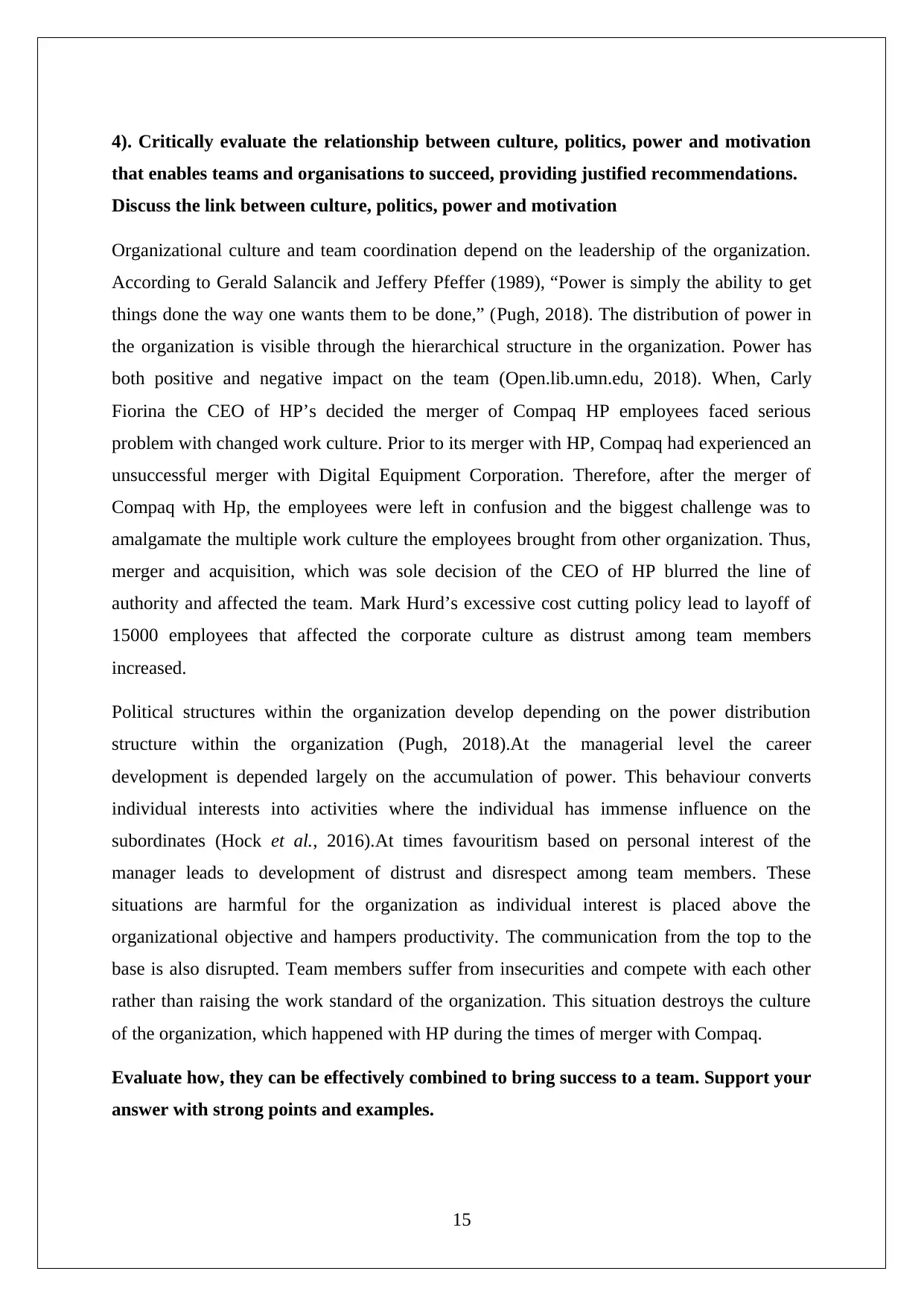
4). Critically evaluate the relationship between culture, politics, power and motivation
that enables teams and organisations to succeed, providing justified recommendations.
Discuss the link between culture, politics, power and motivation
Organizational culture and team coordination depend on the leadership of the organization.
According to Gerald Salancik and Jeffery Pfeffer (1989), “Power is simply the ability to get
things done the way one wants them to be done,” (Pugh, 2018). The distribution of power in
the organization is visible through the hierarchical structure in the organization. Power has
both positive and negative impact on the team (Open.lib.umn.edu, 2018). When, Carly
Fiorina the CEO of HP’s decided the merger of Compaq HP employees faced serious
problem with changed work culture. Prior to its merger with HP, Compaq had experienced an
unsuccessful merger with Digital Equipment Corporation. Therefore, after the merger of
Compaq with Hp, the employees were left in confusion and the biggest challenge was to
amalgamate the multiple work culture the employees brought from other organization. Thus,
merger and acquisition, which was sole decision of the CEO of HP blurred the line of
authority and affected the team. Mark Hurd’s excessive cost cutting policy lead to layoff of
15000 employees that affected the corporate culture as distrust among team members
increased.
Political structures within the organization develop depending on the power distribution
structure within the organization (Pugh, 2018).At the managerial level the career
development is depended largely on the accumulation of power. This behaviour converts
individual interests into activities where the individual has immense influence on the
subordinates (Hock et al., 2016).At times favouritism based on personal interest of the
manager leads to development of distrust and disrespect among team members. These
situations are harmful for the organization as individual interest is placed above the
organizational objective and hampers productivity. The communication from the top to the
base is also disrupted. Team members suffer from insecurities and compete with each other
rather than raising the work standard of the organization. This situation destroys the culture
of the organization, which happened with HP during the times of merger with Compaq.
Evaluate how, they can be effectively combined to bring success to a team. Support your
answer with strong points and examples.
15
that enables teams and organisations to succeed, providing justified recommendations.
Discuss the link between culture, politics, power and motivation
Organizational culture and team coordination depend on the leadership of the organization.
According to Gerald Salancik and Jeffery Pfeffer (1989), “Power is simply the ability to get
things done the way one wants them to be done,” (Pugh, 2018). The distribution of power in
the organization is visible through the hierarchical structure in the organization. Power has
both positive and negative impact on the team (Open.lib.umn.edu, 2018). When, Carly
Fiorina the CEO of HP’s decided the merger of Compaq HP employees faced serious
problem with changed work culture. Prior to its merger with HP, Compaq had experienced an
unsuccessful merger with Digital Equipment Corporation. Therefore, after the merger of
Compaq with Hp, the employees were left in confusion and the biggest challenge was to
amalgamate the multiple work culture the employees brought from other organization. Thus,
merger and acquisition, which was sole decision of the CEO of HP blurred the line of
authority and affected the team. Mark Hurd’s excessive cost cutting policy lead to layoff of
15000 employees that affected the corporate culture as distrust among team members
increased.
Political structures within the organization develop depending on the power distribution
structure within the organization (Pugh, 2018).At the managerial level the career
development is depended largely on the accumulation of power. This behaviour converts
individual interests into activities where the individual has immense influence on the
subordinates (Hock et al., 2016).At times favouritism based on personal interest of the
manager leads to development of distrust and disrespect among team members. These
situations are harmful for the organization as individual interest is placed above the
organizational objective and hampers productivity. The communication from the top to the
base is also disrupted. Team members suffer from insecurities and compete with each other
rather than raising the work standard of the organization. This situation destroys the culture
of the organization, which happened with HP during the times of merger with Compaq.
Evaluate how, they can be effectively combined to bring success to a team. Support your
answer with strong points and examples.
15
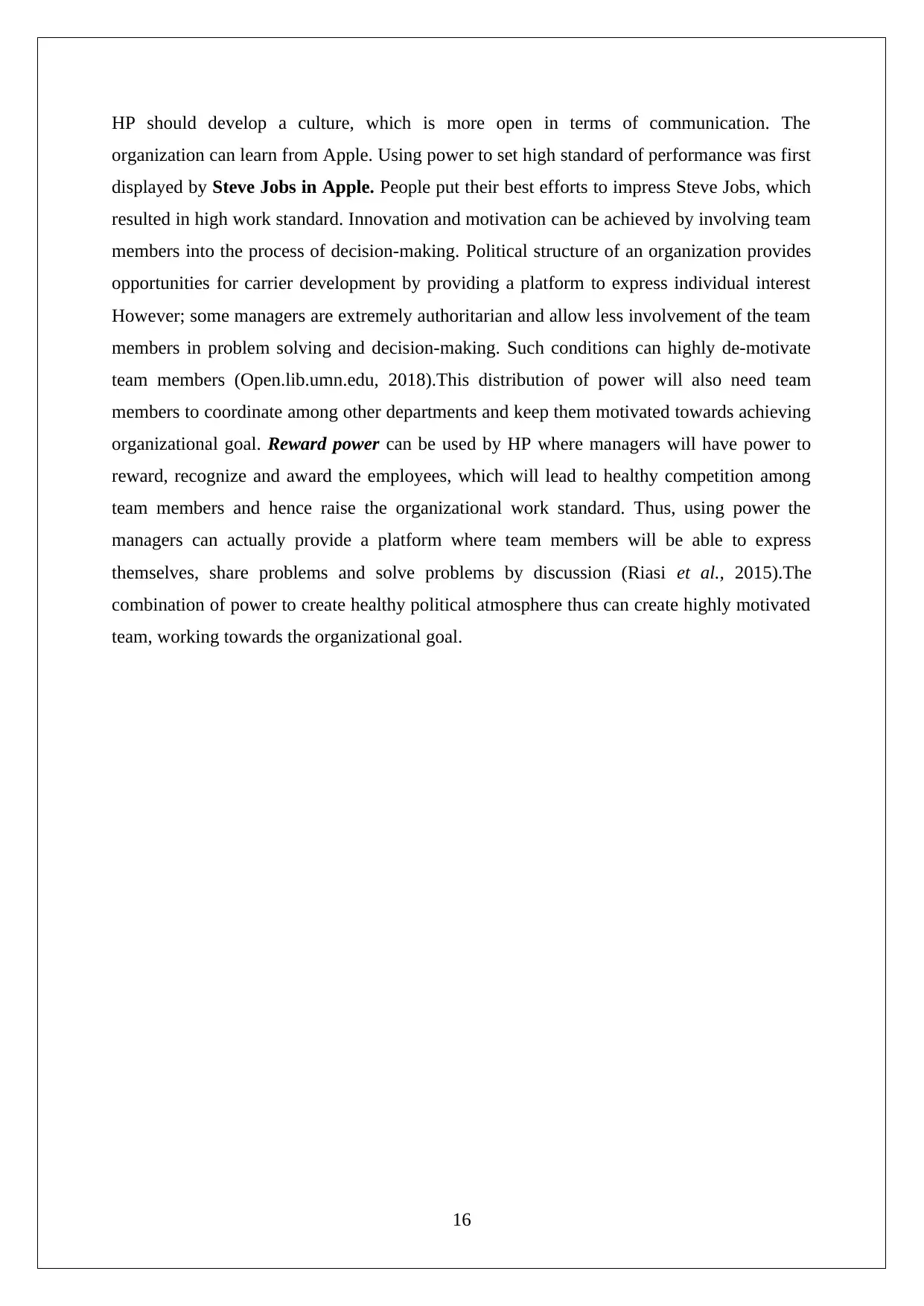
HP should develop a culture, which is more open in terms of communication. The
organization can learn from Apple. Using power to set high standard of performance was first
displayed by Steve Jobs in Apple. People put their best efforts to impress Steve Jobs, which
resulted in high work standard. Innovation and motivation can be achieved by involving team
members into the process of decision-making. Political structure of an organization provides
opportunities for carrier development by providing a platform to express individual interest
However; some managers are extremely authoritarian and allow less involvement of the team
members in problem solving and decision-making. Such conditions can highly de-motivate
team members (Open.lib.umn.edu, 2018).This distribution of power will also need team
members to coordinate among other departments and keep them motivated towards achieving
organizational goal. Reward power can be used by HP where managers will have power to
reward, recognize and award the employees, which will lead to healthy competition among
team members and hence raise the organizational work standard. Thus, using power the
managers can actually provide a platform where team members will be able to express
themselves, share problems and solve problems by discussion (Riasi et al., 2015).The
combination of power to create healthy political atmosphere thus can create highly motivated
team, working towards the organizational goal.
16
organization can learn from Apple. Using power to set high standard of performance was first
displayed by Steve Jobs in Apple. People put their best efforts to impress Steve Jobs, which
resulted in high work standard. Innovation and motivation can be achieved by involving team
members into the process of decision-making. Political structure of an organization provides
opportunities for carrier development by providing a platform to express individual interest
However; some managers are extremely authoritarian and allow less involvement of the team
members in problem solving and decision-making. Such conditions can highly de-motivate
team members (Open.lib.umn.edu, 2018).This distribution of power will also need team
members to coordinate among other departments and keep them motivated towards achieving
organizational goal. Reward power can be used by HP where managers will have power to
reward, recognize and award the employees, which will lead to healthy competition among
team members and hence raise the organizational work standard. Thus, using power the
managers can actually provide a platform where team members will be able to express
themselves, share problems and solve problems by discussion (Riasi et al., 2015).The
combination of power to create healthy political atmosphere thus can create highly motivated
team, working towards the organizational goal.
16
Secure Best Marks with AI Grader
Need help grading? Try our AI Grader for instant feedback on your assignments.
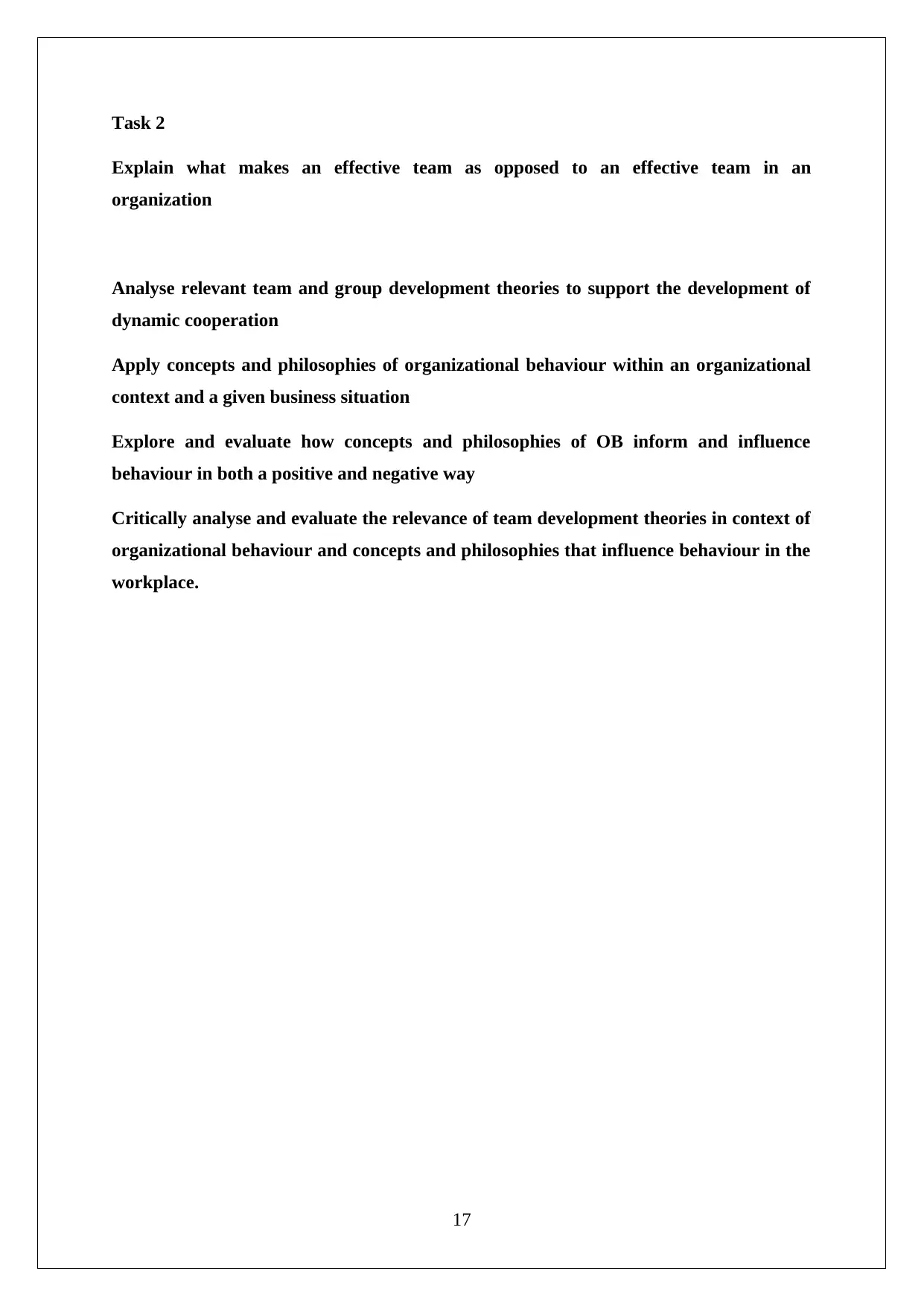
Task 2
Explain what makes an effective team as opposed to an effective team in an
organization
Analyse relevant team and group development theories to support the development of
dynamic cooperation
Apply concepts and philosophies of organizational behaviour within an organizational
context and a given business situation
Explore and evaluate how concepts and philosophies of OB inform and influence
behaviour in both a positive and negative way
Critically analyse and evaluate the relevance of team development theories in context of
organizational behaviour and concepts and philosophies that influence behaviour in the
workplace.
17
Explain what makes an effective team as opposed to an effective team in an
organization
Analyse relevant team and group development theories to support the development of
dynamic cooperation
Apply concepts and philosophies of organizational behaviour within an organizational
context and a given business situation
Explore and evaluate how concepts and philosophies of OB inform and influence
behaviour in both a positive and negative way
Critically analyse and evaluate the relevance of team development theories in context of
organizational behaviour and concepts and philosophies that influence behaviour in the
workplace.
17
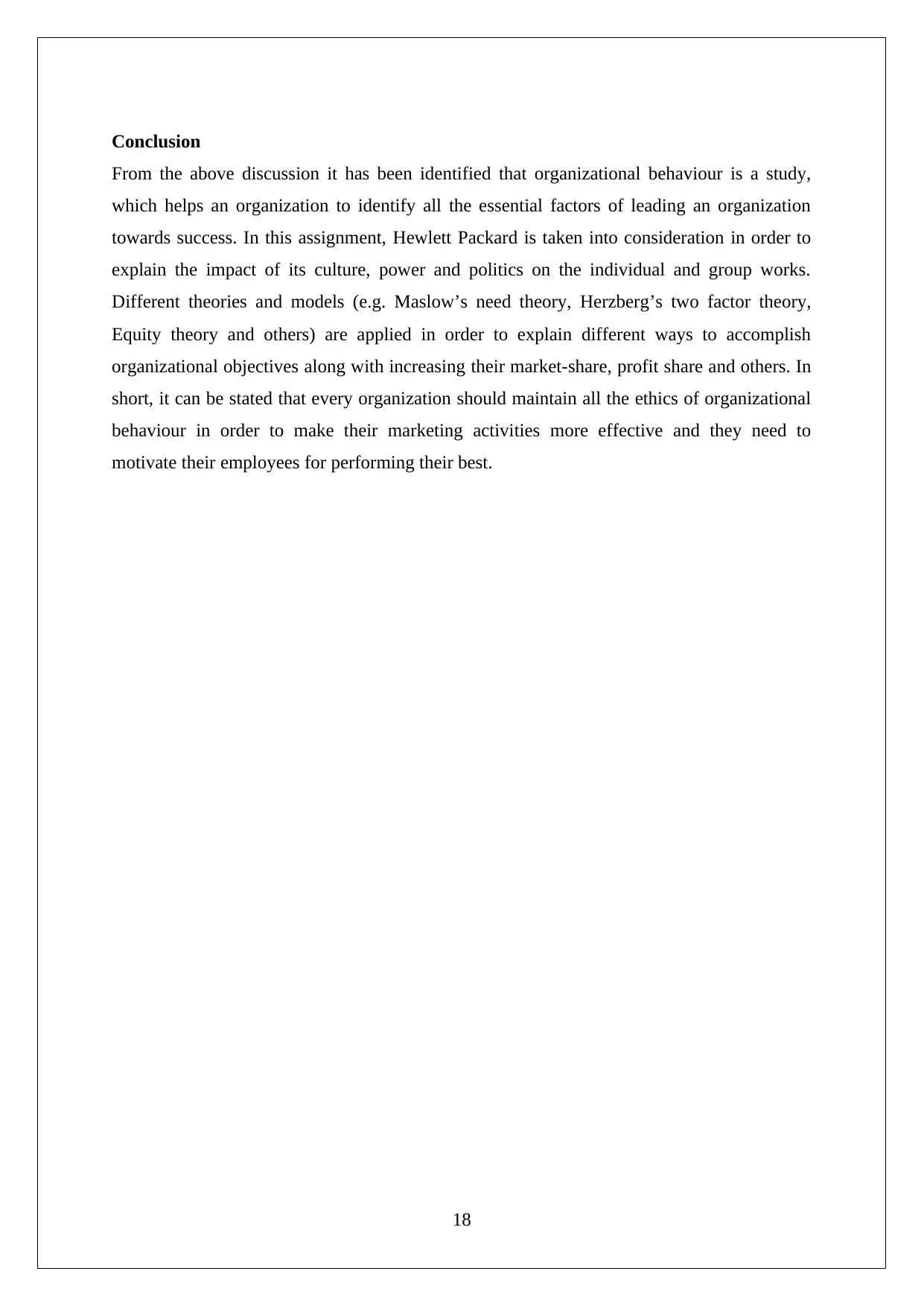
Conclusion
From the above discussion it has been identified that organizational behaviour is a study,
which helps an organization to identify all the essential factors of leading an organization
towards success. In this assignment, Hewlett Packard is taken into consideration in order to
explain the impact of its culture, power and politics on the individual and group works.
Different theories and models (e.g. Maslow’s need theory, Herzberg’s two factor theory,
Equity theory and others) are applied in order to explain different ways to accomplish
organizational objectives along with increasing their market-share, profit share and others. In
short, it can be stated that every organization should maintain all the ethics of organizational
behaviour in order to make their marketing activities more effective and they need to
motivate their employees for performing their best.
18
From the above discussion it has been identified that organizational behaviour is a study,
which helps an organization to identify all the essential factors of leading an organization
towards success. In this assignment, Hewlett Packard is taken into consideration in order to
explain the impact of its culture, power and politics on the individual and group works.
Different theories and models (e.g. Maslow’s need theory, Herzberg’s two factor theory,
Equity theory and others) are applied in order to explain different ways to accomplish
organizational objectives along with increasing their market-share, profit share and others. In
short, it can be stated that every organization should maintain all the ethics of organizational
behaviour in order to make their marketing activities more effective and they need to
motivate their employees for performing their best.
18
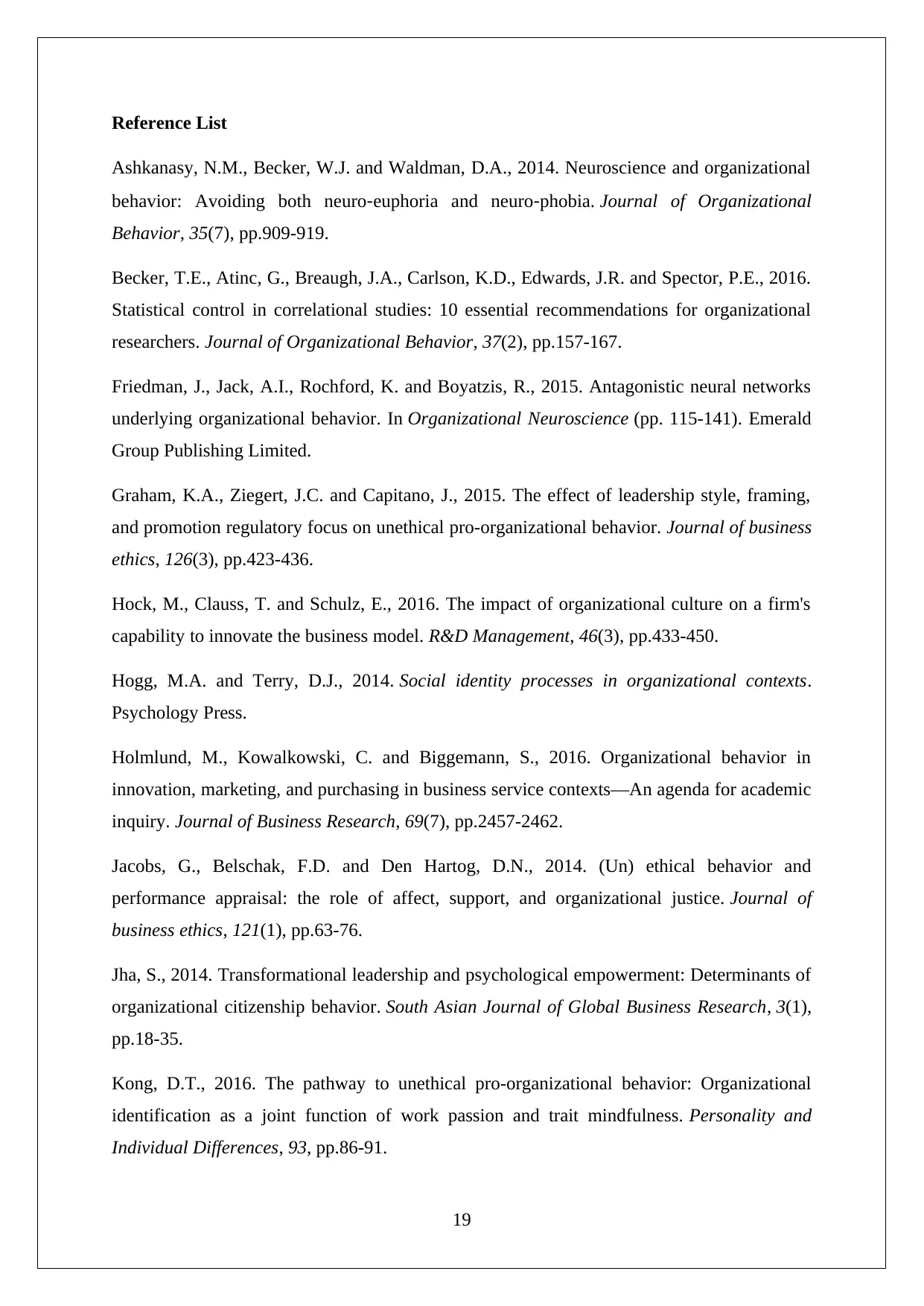
Reference List
Ashkanasy, N.M., Becker, W.J. and Waldman, D.A., 2014. Neuroscience and organizational
behavior: Avoiding both neuro‐euphoria and neuro‐phobia. Journal of Organizational
Behavior, 35(7), pp.909-919.
Becker, T.E., Atinc, G., Breaugh, J.A., Carlson, K.D., Edwards, J.R. and Spector, P.E., 2016.
Statistical control in correlational studies: 10 essential recommendations for organizational
researchers. Journal of Organizational Behavior, 37(2), pp.157-167.
Friedman, J., Jack, A.I., Rochford, K. and Boyatzis, R., 2015. Antagonistic neural networks
underlying organizational behavior. In Organizational Neuroscience (pp. 115-141). Emerald
Group Publishing Limited.
Graham, K.A., Ziegert, J.C. and Capitano, J., 2015. The effect of leadership style, framing,
and promotion regulatory focus on unethical pro-organizational behavior. Journal of business
ethics, 126(3), pp.423-436.
Hock, M., Clauss, T. and Schulz, E., 2016. The impact of organizational culture on a firm's
capability to innovate the business model. R&D Management, 46(3), pp.433-450.
Hogg, M.A. and Terry, D.J., 2014. Social identity processes in organizational contexts.
Psychology Press.
Holmlund, M., Kowalkowski, C. and Biggemann, S., 2016. Organizational behavior in
innovation, marketing, and purchasing in business service contexts—An agenda for academic
inquiry. Journal of Business Research, 69(7), pp.2457-2462.
Jacobs, G., Belschak, F.D. and Den Hartog, D.N., 2014. (Un) ethical behavior and
performance appraisal: the role of affect, support, and organizational justice. Journal of
business ethics, 121(1), pp.63-76.
Jha, S., 2014. Transformational leadership and psychological empowerment: Determinants of
organizational citizenship behavior. South Asian Journal of Global Business Research, 3(1),
pp.18-35.
Kong, D.T., 2016. The pathway to unethical pro-organizational behavior: Organizational
identification as a joint function of work passion and trait mindfulness. Personality and
Individual Differences, 93, pp.86-91.
19
Ashkanasy, N.M., Becker, W.J. and Waldman, D.A., 2014. Neuroscience and organizational
behavior: Avoiding both neuro‐euphoria and neuro‐phobia. Journal of Organizational
Behavior, 35(7), pp.909-919.
Becker, T.E., Atinc, G., Breaugh, J.A., Carlson, K.D., Edwards, J.R. and Spector, P.E., 2016.
Statistical control in correlational studies: 10 essential recommendations for organizational
researchers. Journal of Organizational Behavior, 37(2), pp.157-167.
Friedman, J., Jack, A.I., Rochford, K. and Boyatzis, R., 2015. Antagonistic neural networks
underlying organizational behavior. In Organizational Neuroscience (pp. 115-141). Emerald
Group Publishing Limited.
Graham, K.A., Ziegert, J.C. and Capitano, J., 2015. The effect of leadership style, framing,
and promotion regulatory focus on unethical pro-organizational behavior. Journal of business
ethics, 126(3), pp.423-436.
Hock, M., Clauss, T. and Schulz, E., 2016. The impact of organizational culture on a firm's
capability to innovate the business model. R&D Management, 46(3), pp.433-450.
Hogg, M.A. and Terry, D.J., 2014. Social identity processes in organizational contexts.
Psychology Press.
Holmlund, M., Kowalkowski, C. and Biggemann, S., 2016. Organizational behavior in
innovation, marketing, and purchasing in business service contexts—An agenda for academic
inquiry. Journal of Business Research, 69(7), pp.2457-2462.
Jacobs, G., Belschak, F.D. and Den Hartog, D.N., 2014. (Un) ethical behavior and
performance appraisal: the role of affect, support, and organizational justice. Journal of
business ethics, 121(1), pp.63-76.
Jha, S., 2014. Transformational leadership and psychological empowerment: Determinants of
organizational citizenship behavior. South Asian Journal of Global Business Research, 3(1),
pp.18-35.
Kong, D.T., 2016. The pathway to unethical pro-organizational behavior: Organizational
identification as a joint function of work passion and trait mindfulness. Personality and
Individual Differences, 93, pp.86-91.
19
Paraphrase This Document
Need a fresh take? Get an instant paraphrase of this document with our AI Paraphraser
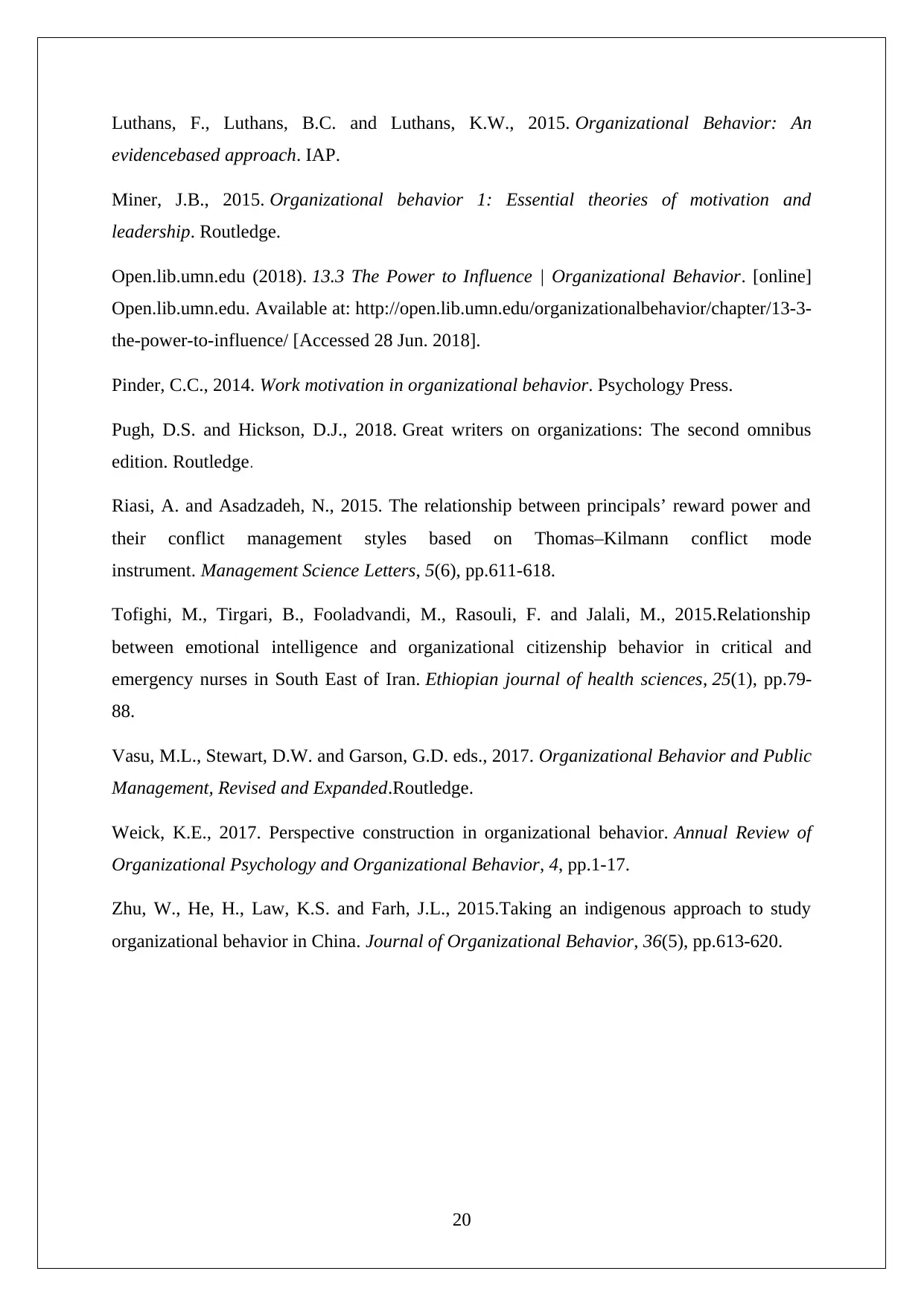
Luthans, F., Luthans, B.C. and Luthans, K.W., 2015. Organizational Behavior: An
evidencebased approach. IAP.
Miner, J.B., 2015. Organizational behavior 1: Essential theories of motivation and
leadership. Routledge.
Open.lib.umn.edu (2018). 13.3 The Power to Influence | Organizational Behavior. [online]
Open.lib.umn.edu. Available at: http://open.lib.umn.edu/organizationalbehavior/chapter/13-3-
the-power-to-influence/ [Accessed 28 Jun. 2018].
Pinder, C.C., 2014. Work motivation in organizational behavior. Psychology Press.
Pugh, D.S. and Hickson, D.J., 2018. Great writers on organizations: The second omnibus
edition. Routledge.
Riasi, A. and Asadzadeh, N., 2015. The relationship between principals’ reward power and
their conflict management styles based on Thomas–Kilmann conflict mode
instrument. Management Science Letters, 5(6), pp.611-618.
Tofighi, M., Tirgari, B., Fooladvandi, M., Rasouli, F. and Jalali, M., 2015.Relationship
between emotional intelligence and organizational citizenship behavior in critical and
emergency nurses in South East of Iran. Ethiopian journal of health sciences, 25(1), pp.79-
88.
Vasu, M.L., Stewart, D.W. and Garson, G.D. eds., 2017. Organizational Behavior and Public
Management, Revised and Expanded.Routledge.
Weick, K.E., 2017. Perspective construction in organizational behavior. Annual Review of
Organizational Psychology and Organizational Behavior, 4, pp.1-17.
Zhu, W., He, H., Law, K.S. and Farh, J.L., 2015.Taking an indigenous approach to study
organizational behavior in China. Journal of Organizational Behavior, 36(5), pp.613-620.
20
evidencebased approach. IAP.
Miner, J.B., 2015. Organizational behavior 1: Essential theories of motivation and
leadership. Routledge.
Open.lib.umn.edu (2018). 13.3 The Power to Influence | Organizational Behavior. [online]
Open.lib.umn.edu. Available at: http://open.lib.umn.edu/organizationalbehavior/chapter/13-3-
the-power-to-influence/ [Accessed 28 Jun. 2018].
Pinder, C.C., 2014. Work motivation in organizational behavior. Psychology Press.
Pugh, D.S. and Hickson, D.J., 2018. Great writers on organizations: The second omnibus
edition. Routledge.
Riasi, A. and Asadzadeh, N., 2015. The relationship between principals’ reward power and
their conflict management styles based on Thomas–Kilmann conflict mode
instrument. Management Science Letters, 5(6), pp.611-618.
Tofighi, M., Tirgari, B., Fooladvandi, M., Rasouli, F. and Jalali, M., 2015.Relationship
between emotional intelligence and organizational citizenship behavior in critical and
emergency nurses in South East of Iran. Ethiopian journal of health sciences, 25(1), pp.79-
88.
Vasu, M.L., Stewart, D.W. and Garson, G.D. eds., 2017. Organizational Behavior and Public
Management, Revised and Expanded.Routledge.
Weick, K.E., 2017. Perspective construction in organizational behavior. Annual Review of
Organizational Psychology and Organizational Behavior, 4, pp.1-17.
Zhu, W., He, H., Law, K.S. and Farh, J.L., 2015.Taking an indigenous approach to study
organizational behavior in China. Journal of Organizational Behavior, 36(5), pp.613-620.
20
1 out of 20
Related Documents
Your All-in-One AI-Powered Toolkit for Academic Success.
+13062052269
info@desklib.com
Available 24*7 on WhatsApp / Email
![[object Object]](/_next/static/media/star-bottom.7253800d.svg)
Unlock your academic potential
© 2024 | Zucol Services PVT LTD | All rights reserved.





